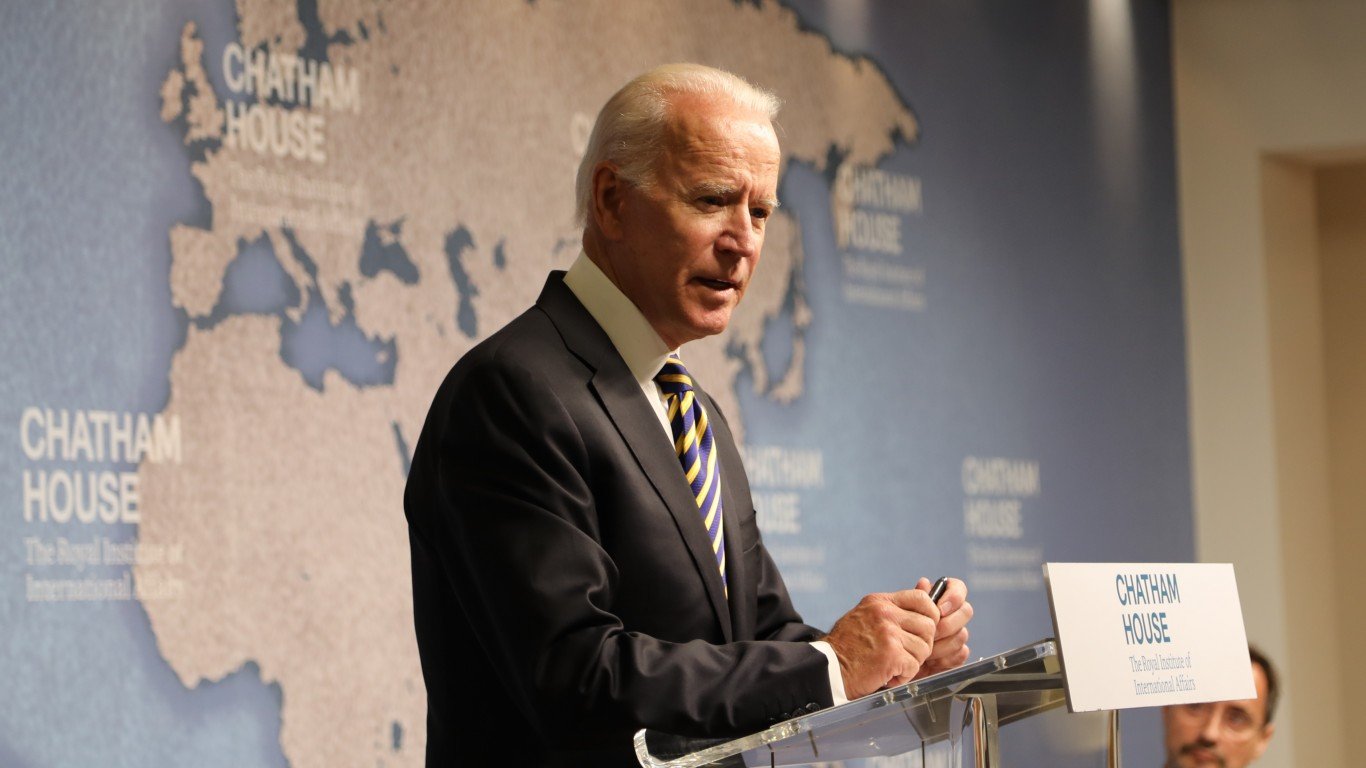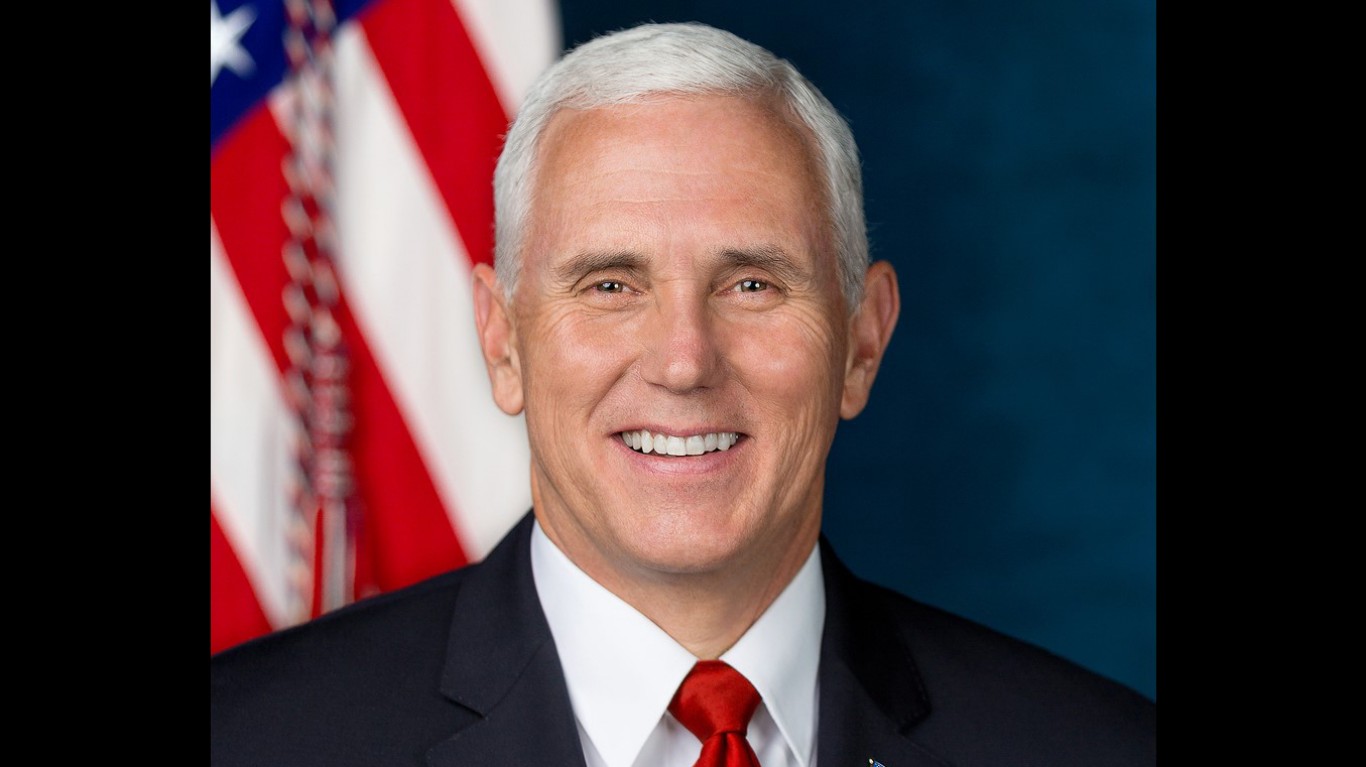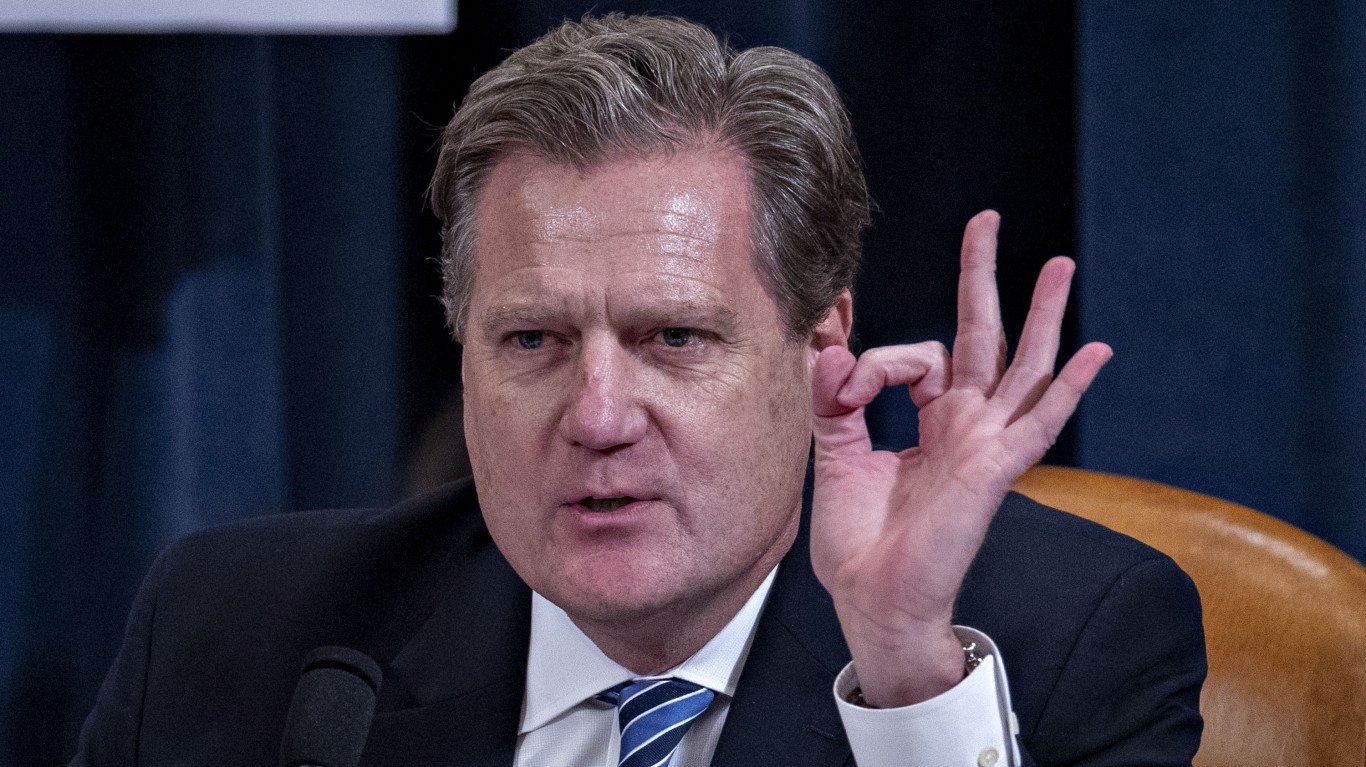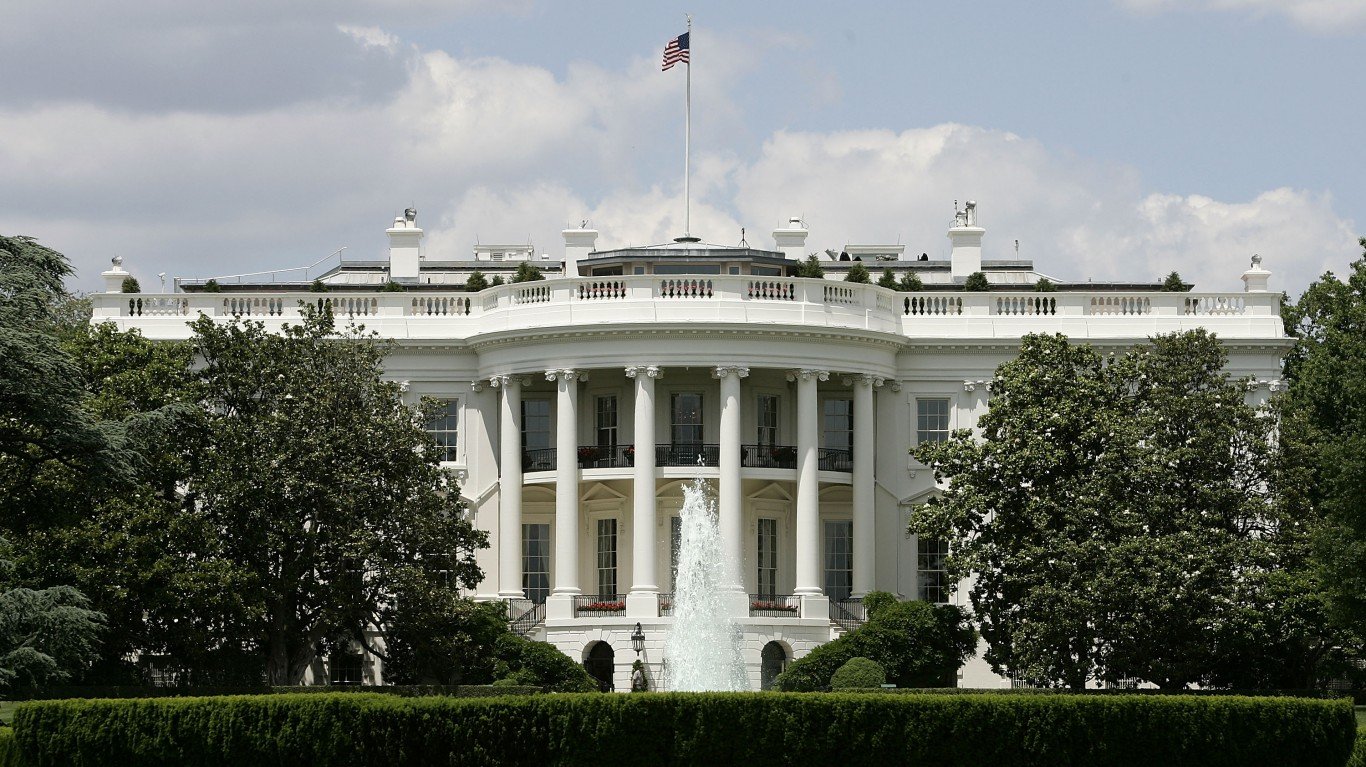

It’s been said that the American vice president may be a heartbeat away from the most powerful office in the world. And on Aug. 11, California Sen. Kamala Harris made history after presumptive Democratic presidential candidate Joe Biden selected her as his running mate. Harris is the first woman of color, and third woman overall, to be nominated by a major political party as vice president.
The job has held little respect since John Adams became the first VP in 1797. John Nance Garner, vice president under Franklin Roosevelt for eight years, famously disparaged the office when he said it “is not worth a bucket of warm spit.” Still, in recent years, the vice president has had more and more clout and responsibilities. Vice president Mike Pence is responsible for the administration’s national response to the COVID-19 pandemic.
In acknowledgment of this history-making decision, 24/7 Wall St. has compiled a list of the people who have served as vice president of the United States. We created the list using information and data from senate.gov, and history, and archives website of the House of Representatives, as well as information from websites such as The Week.
Click here to see all 48 people who became vice president.
The office originally was occupied by the person defeated in the presidential election, but because of the enmity between President John Adams and Vice President Thomas Jefferson in the late 18th century, Congress ratified the 12th Amendment in 1804, mandating presidential and vice presidential candidates run on the same ticket.
Since then, vice presidential candidates have served as vote generators, a way to create geographical balance, provide experience or expertise in a particular area such as foreign policy, or go on the attack against the competing party. These are the presidents with the best and worst relationships with Congress.
Fourteen former vice presidents have become president, with more than half of them assuming the office after a chief executive had died. Three have received the Nobel Peace Prize, most recently Al Gore Jr. in 2007, though none got the award while in office. Two VPs have resigned and seven died while in office. Here is each president’s path to the Oval Office.
American presidencies have gone stretches without a vice president — once for 10 years — with little consequence. When Lyndon Johnson became president in 1963 following the assassination of John F. Kennedy, the vice presidency was vacant until 1965. To avoid this situation again, Congress ratified the 25th Amendment in 1967 to make clear that a vice president who replaces a president is officially the chief executive of the United States.
Harry Truman knew first hand of the danger of a vice president kept in the dark about the nation’s top secrets. Truman was vice president for only a few months when Franklin Roosevelt died in 1945, and he knew little about the development of an atomic bomb until after he became president. He resolved that no vice president should be kept out of the intelligence loop again. The National Security Act of 1947 gave the VP a place on the National Security Council.
More recent presidents have entrusted the nation’s No. 2 executive with more responsibilities. Richard Nixon represented Dwight D. Eisenhower on goodwill missions abroad; Bill Clinton entrusted Al Gore on policy regarding the environment; and Donald Trump put Mike Pence in charge of coordinating America’s response to the pandemic.
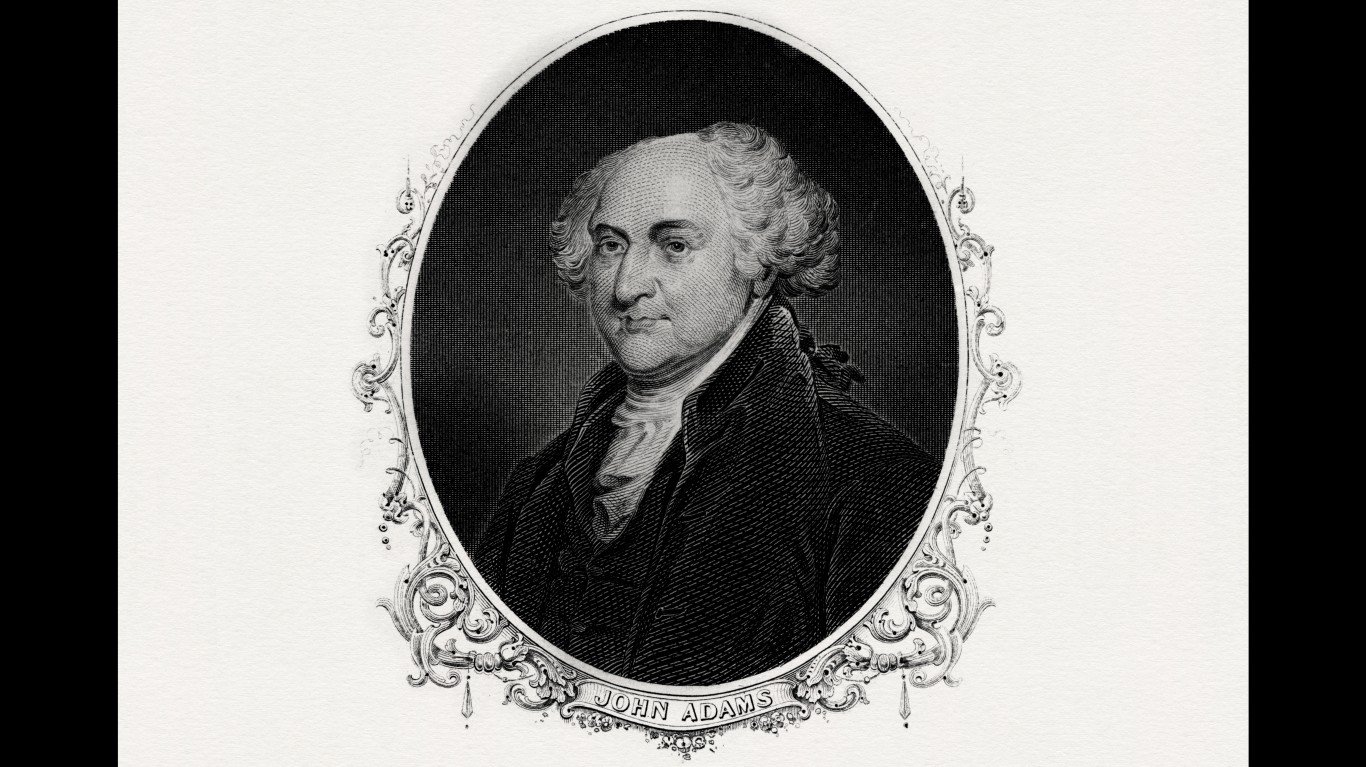
1. John Adams
> Presidential administration(s): George Washington
> Year(s) in office: 1789 – 1797
> Party affiliation: Federalist
John Adams was a Founding Father and one of several vice presidents who eventually ascended to the presidency. As a lawyer practicing in Massachusetts, Adams headed the legal defense for the British soldiers involved in the Boston Massacre — an unpopular decision at the time, but one that demonstrated his integrity and firm belief in justice for all.
Years later, Adams was one of the American diplomats who negotiated the Treaty of Paris, which ended the Revolutionary War. Following the war, Adams ran for president, losing to George Washington, and according to the rules at the time, he was designated as vice president. This happened again in the following election. At the end of Washington’s second term, Adams ran for president again, this time defeating Thomas Jefferson.
[in-text-ad]
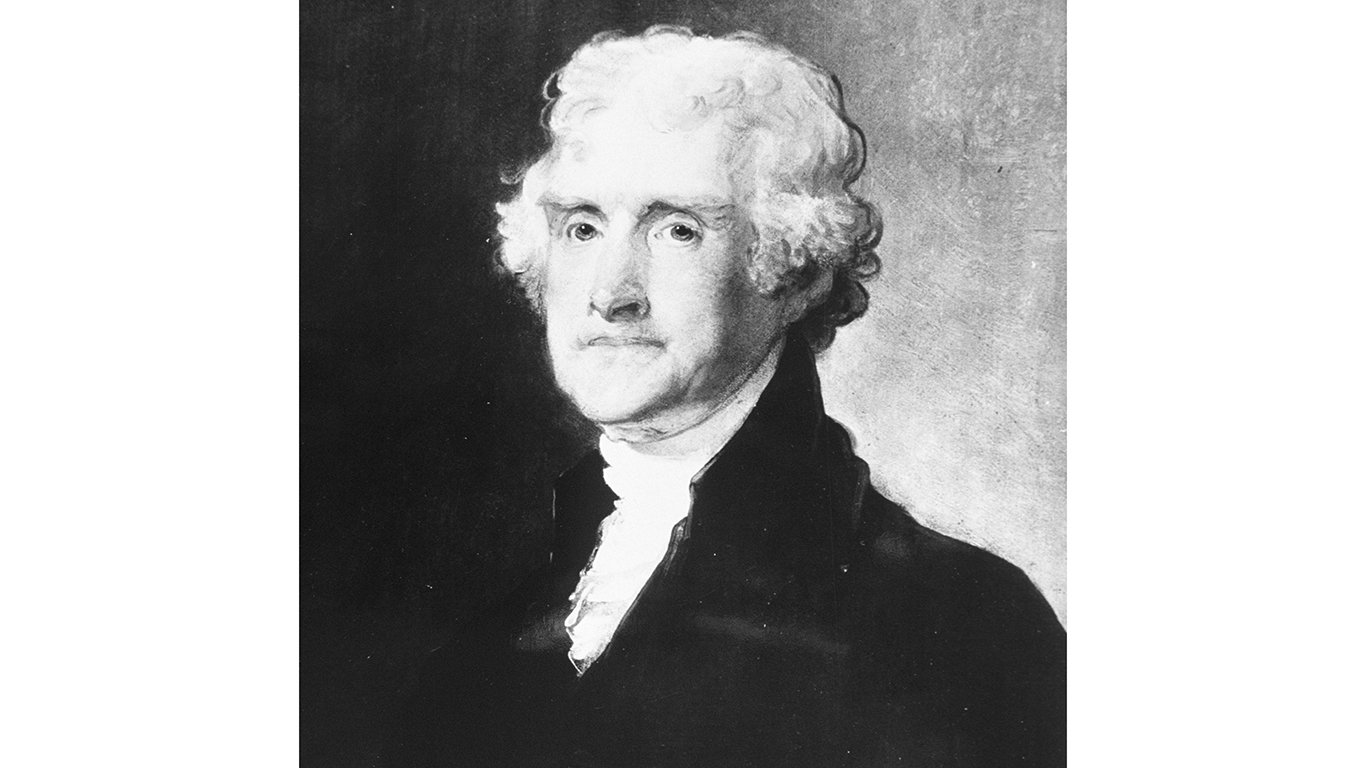
2. Thomas Jefferson
> Presidential administration(s): John Adams
> Year(s) in office: 1797 – 1801
> Party affiliation: Democratic-Republican
Thomas Jefferson’s service as vice president to John Adams is overshadowed in the history books by his other influences on American politics and society. Before becoming the vice president after losing a bid for the presidency, Jefferson authored the Declaration of Independence and founded the Democratic-Republican political party.
In his second bid for president in 1800, Jefferson defeated Adams and became the third U.S. president in 1801. As president, Jefferson purchased the Louisiana Territory, effectively doubling the size of the country. Jefferson also helped found the University of Virginia, and today, his likeness stands alongside three other U.S. presidents on Mount Rushmore.
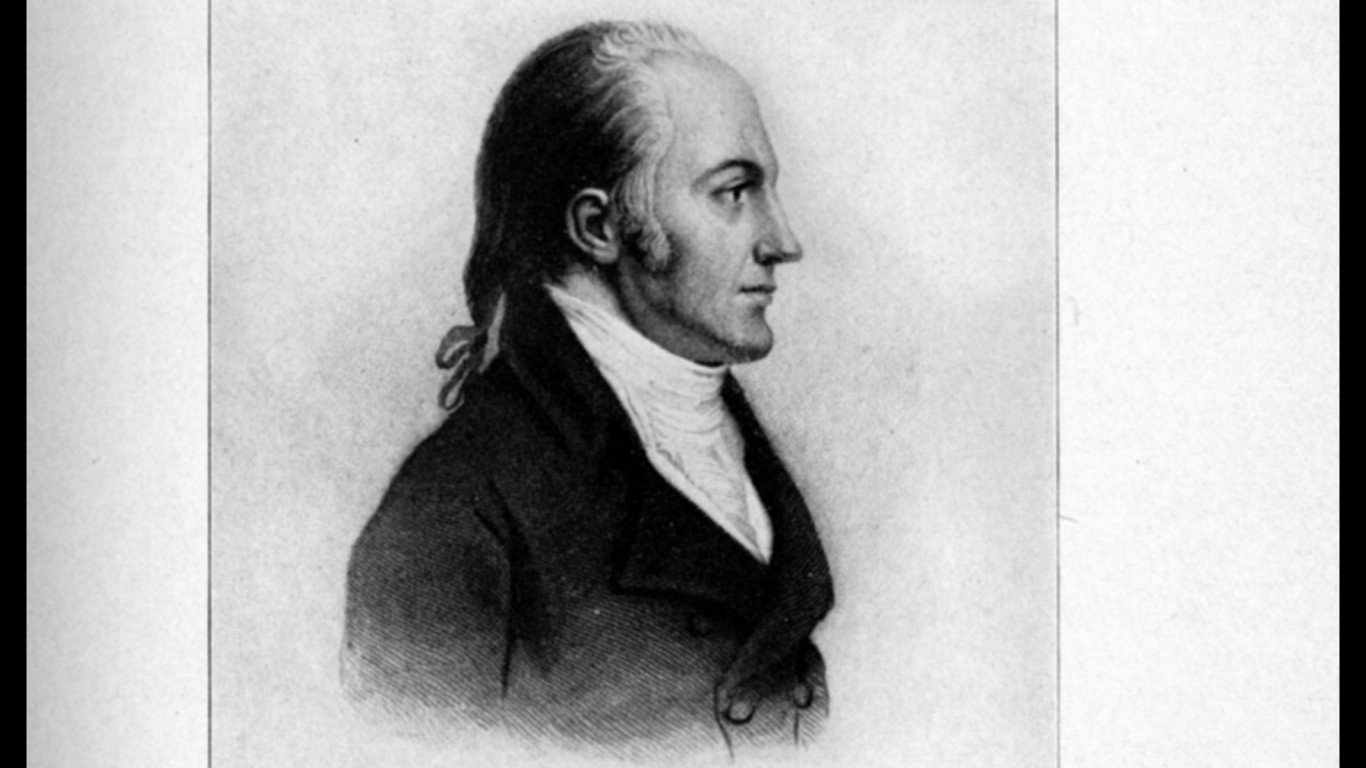
3. Aaron Burr
> Presidential administration(s): Thomas Jefferson
> Year(s) in office: 1801 – 1805
> Party affiliation: Democratic-Republican
Aaron Burr, the third vice president of the United States, has gone down in history as something of a villain. Years after serving in the Revolutionary War under George Washington, Burr ran for president against Thomas Jefferson, and though he received the same number of electoral votes, the House of Representatives decided to choose Jefferson as president, relegating Burr to the vice presidency.
Near the end of his term of service, Burr ran for governor of New York and lost. He blamed both losses on political rival Alexander Hamilton and challenged Hamilton to a duel, fatally shooting him in the fight. Burr faced outrage for killing Hamilton. Three years later, Burr was brought up on conspiracy charges for trying to separate territories from the United States. Though he was ultimately acquitted, Burr’s image never recovered.
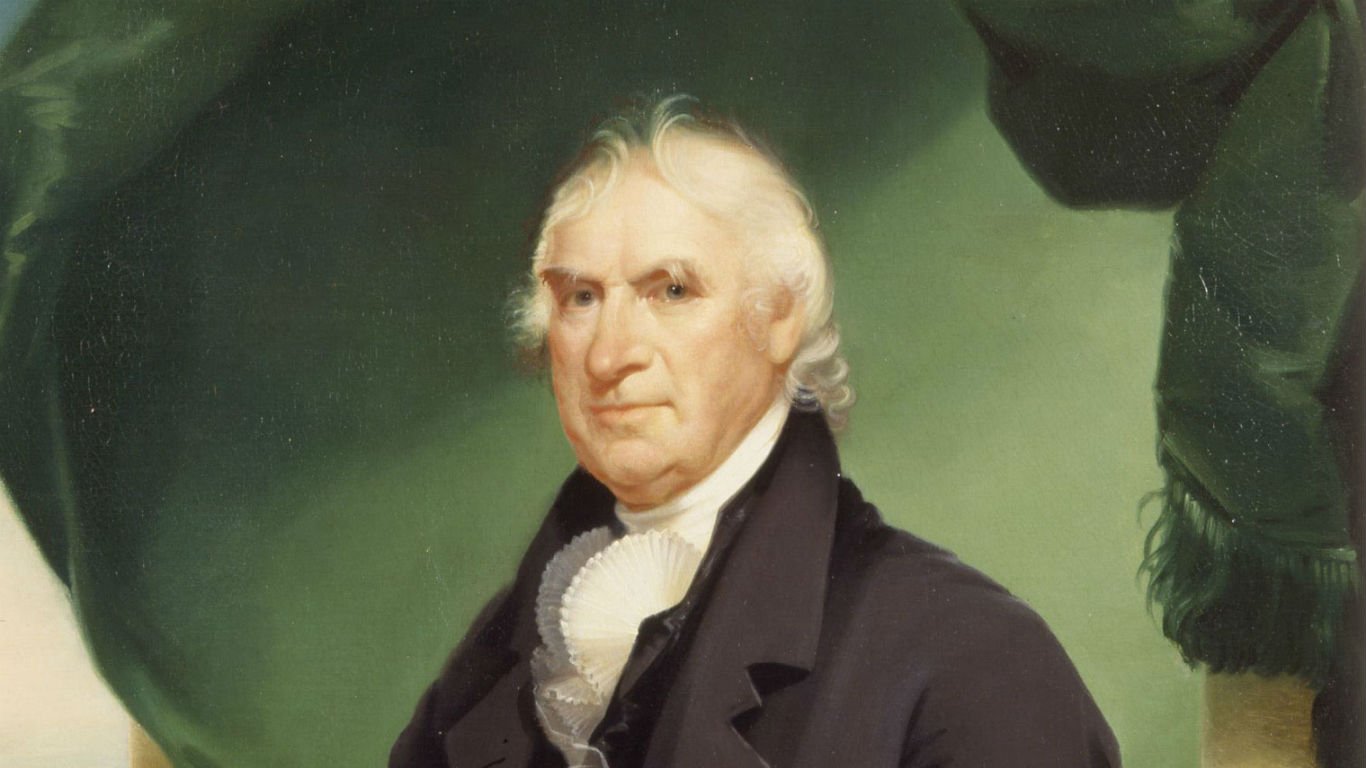
4. George Clinton
> Presidential administration(s): Thomas Jefferson, James Madison
> Year(s) in office: 1805 – 1812
> Party affiliation: Democratic-Republican
George Clinton was a staunch follower of Thomas Jefferson and served as vice president during Jefferson’s second term. Like every vice president who came before, Clinton also ran for president himself. Also like each of his vice presidential forerunners did at one point or another, he lost. Clinton ended up serving as vice president yet again under President James Madison. His health began declining, however, and he died in office before the end of Madison’s first term.
Unlike many of those who served in the executive branch before him, Clinton actually opposed the ratification of the U.S. Constitution. He had served 21 years as the governor of New York before going to Washington, and believed that granting the federal government too much power would undermine New York state’s economic advantages.
[in-text-ad-2]
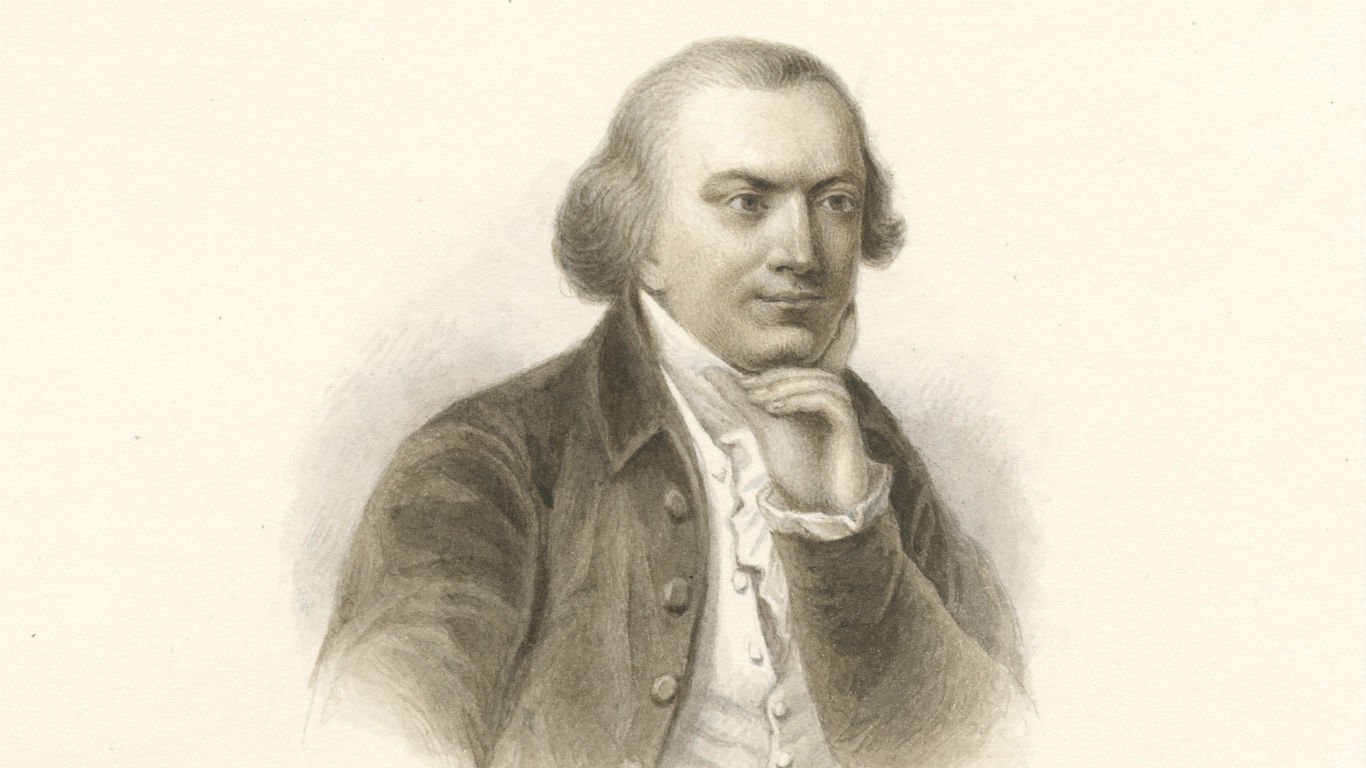
5. Elbridge Gerry
> Presidential administration(s): James Madison
> Year(s) in office: 1813 – 1814
> Party affiliation: Democratic-Republican
Elbridge Gerry was the fifth vice president of the United States, serving under President James Madison following the death of George Clinton. Like Clinton, Gerry was a strong critic of the U.S. Constitution during the drafting. He fought for provisions he believed would better protect individual liberties. While Gerry did not succeed incorporating these measures and famously did not sign the Constitution, he supported the document after its ratification.
Before ascending to the vice presidency, Gerry served as governor of Massachusetts, and during his tenure became known for dividing voting districts for political advantage — a practice that has become to be known as gerrymandering in reference to the former vice president.
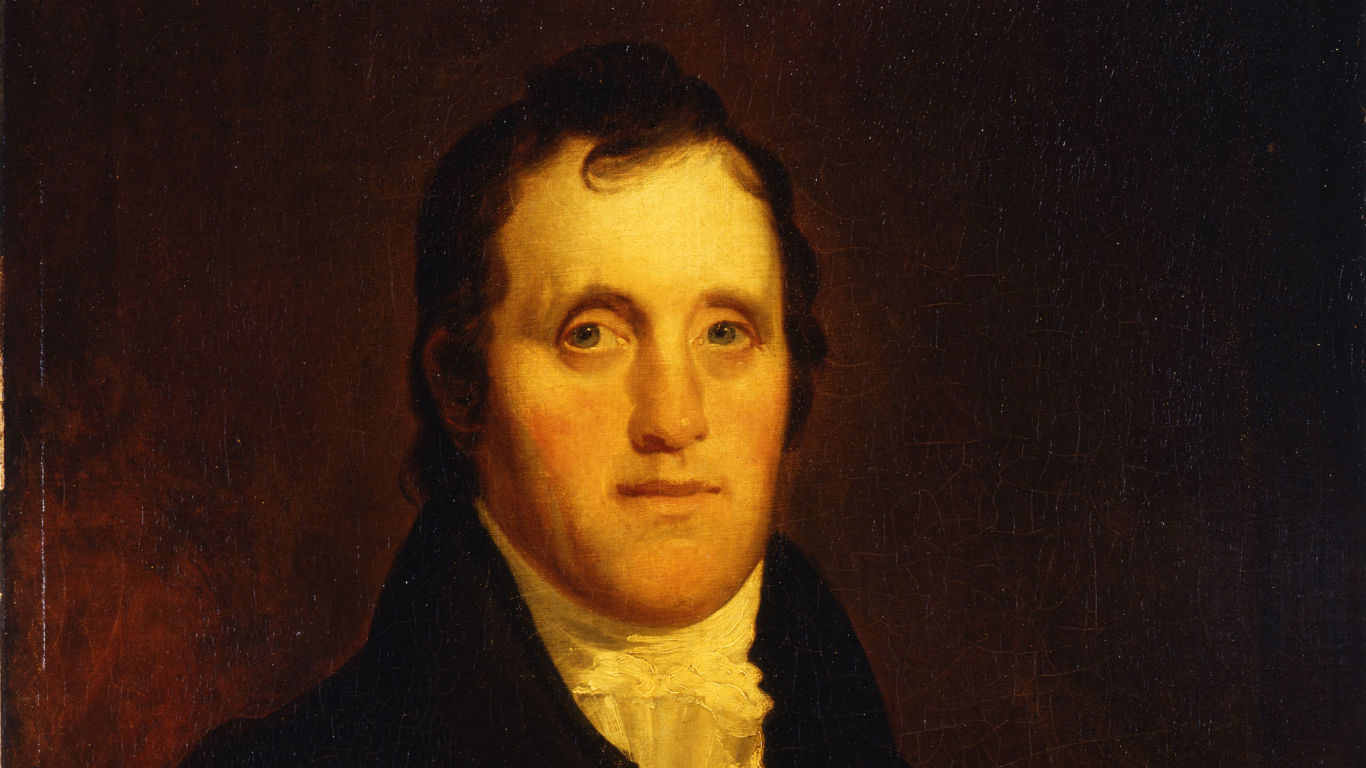
6. Daniel D. Tompkins
> Presidential administration(s): James Monroe
> Year(s) in office: 1817 – 1825
> Party affiliation: Democratic-Republican
Daniel D. Tompkins was one of 11 children born to a tenant farmer. He built his political connections through his father-in-law, a member of the Tammy Society, which challenged for control of New York’s Republican Party in the early 19th century. Tompkins’ leadership skills eventually led to his election as governor of New York. Tompkins helped pass legislation outlawing slavery in New York.
Tompkins was selected by the Democratic-Republican Party to run as a vice presidential candidate with James Monroe of Virginia in 1816 to gain support of the New York wing of the party, which believed Virginia was dominating the presidency. Tompkins’ tenure as VP was hampered by allegations over financial improprieties stemming from claims he misused public money for the defense of New York during the War of 1812. His health was also impaired because of injuries sustained from falling from a horse, and he had a drinking problem. Tompkins was absent much of his time as vice president, and when he was able to attend proceedings of the Senate, he was unable to control debate over contentious issues such as the admission of Missouri to the Union.
[in-text-ad]
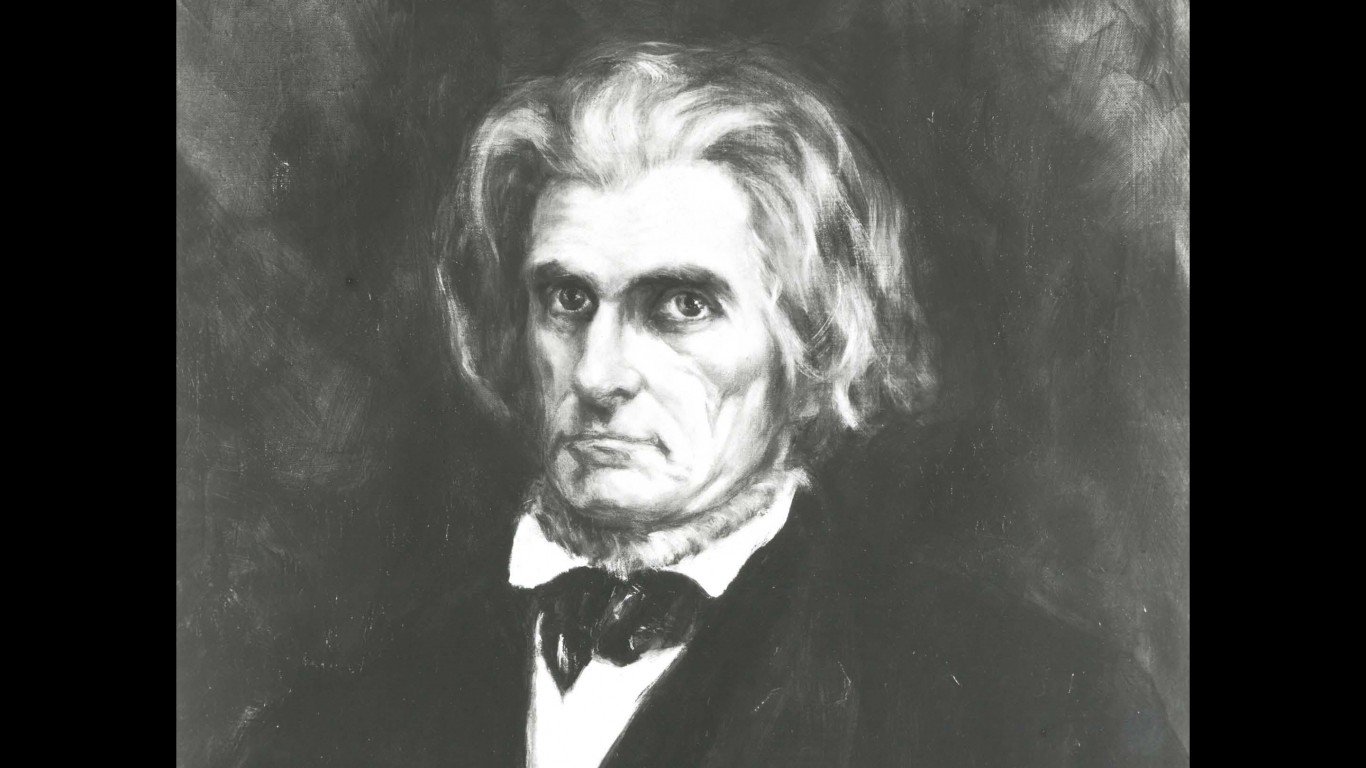
7. John C. Calhoun
> Presidential administration(s): John Quincy Adams, Andrew Jackson
> Year(s) in office: 1825 – 1832
> Party affiliation: National Republican
John C. Calhoun served as vice president under two presidents. Originally, Calhoun himself sought the presidency, and while popular among many voters, he never garnered the support necessary and instead opted for the vice presidency, with broad support from his party. First, Calhoun served under John Quincy Adams, son of the second president, and a personal friend of Calhoun’s. He then served under Andew Jackson, a position he resigned from in 1832, citing political differences with the commander-in-chief and a desire to fill a Senate seat in his native South Carolina.
After the executive branch, Calhoun served out the rest of his political career as a South Carolina senator and a staunch supporter of slavery.
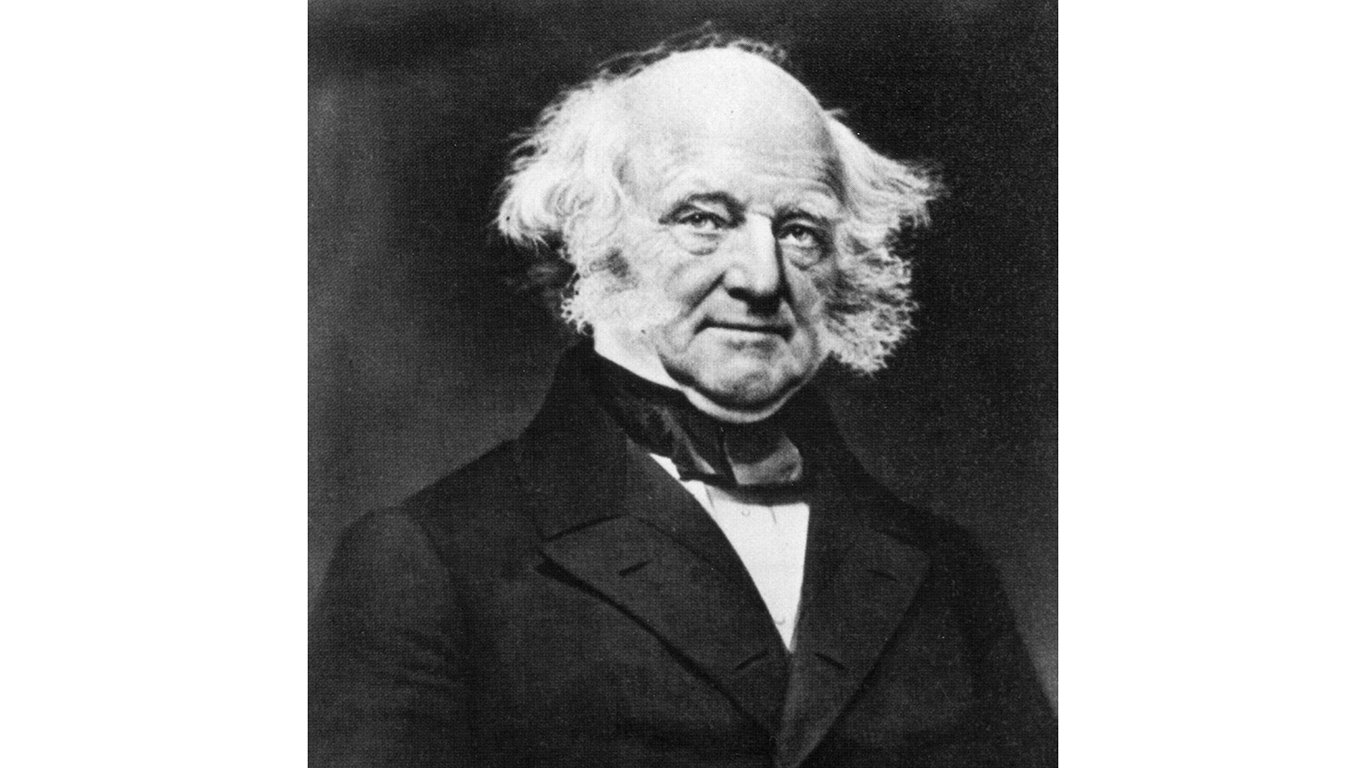
8. Martin Van Buren
> Presidential administration(s): Andrew Jackson
> Year(s) in office: 1833 – 1837
> Party affiliation: Democratic
Though not formally educated like many politicians of his day, Martin Van Buren had a sharp political acumen developed in the rough and tumble New York politics of the early 19th century, earning him nicknames like “the American Talleyrand” and “the Red Fox of Kinderhook.”
Van Buren worked his way up through New York politics and eventually became governor. He realized early on the importance of party organization as well as patronage. Van Buren was instrumental in Andrew Jackson’s presidential triumph in 1828 and became his key adviser. Jackson appointed Van Buren secretary of state in 1829. In his second term, Jackson picked Van Buren as vice president, and as the president’s confidant, Van Buren navigated contentious issues such as the Jackson’s opposition to a national bank and slavery. Van Buren became president in 1837 — the first president of Dutch descent, and the first one to be born in the U.S. — and served one term.
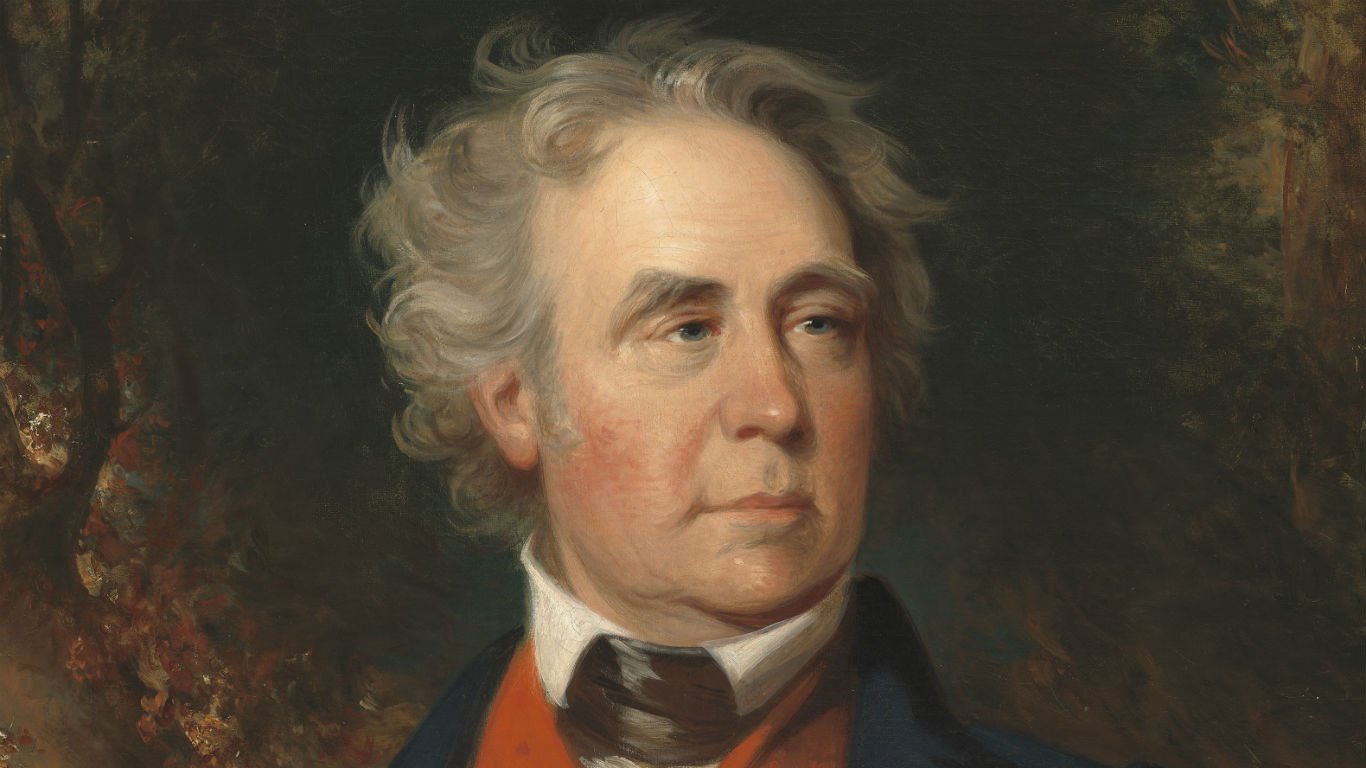
9. Richard Mentor Johnson
> Presidential administration(s): Martin Van Buren
> Year(s) in office: 1837 – 1841
> Party affiliation: Democratic
In the early days of the United States, vice presidents were selected by the electoral college. When Martin Van Buren was elected president in 1836, the electoral college could not agree on one of the four vice presidential candidates. As a result, for the first time in history, the Senate made the decision and appointed Richard Mentor Johnson.
Johnson was not especially popular with his party during his term as vice president — partly because of his personal life, as he fathered two children with a slave to whom he was not married. Johnson was not supported by his party in Van Buren’s campaign for reelection, and the Democratic party lost control of the executive branch to the Whig Party.
[in-text-ad-2]
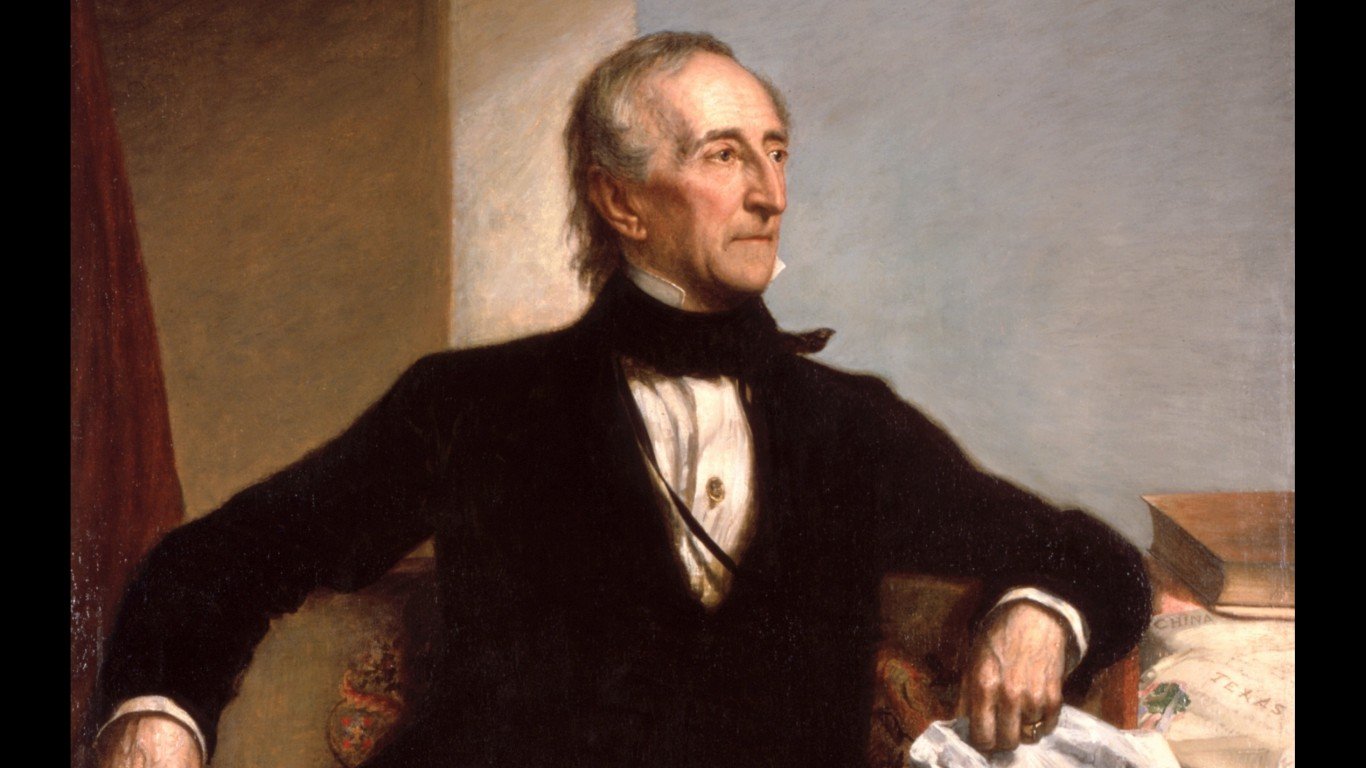
10. John Tyler
> Presidential administration(s): William H. Harrison
> Year(s) in office: 1841
> Party affiliation: Whig
John Tyler was the first vice president to become president after the death of his predecessor. Tyler, a slave-holding plantation owner from Virginia, was picked to run with William H. Harrison — a war hero who represented Ohio in the House of Representatives and the Senate — to provide geographic and ideological balance. Harrison died just 33 days into office, and this led to some confusion over succession, since the Constitution was unclear on that issue.
Tyler was considered to be an acting president, and his detractors called him “His Accidency.” Tyler refused to be called an acting president and he strengthened the vice president’s office by insisting that in the event of a presidential vacancy, the vice president would assume the chief executive’s full powers with the title of president.
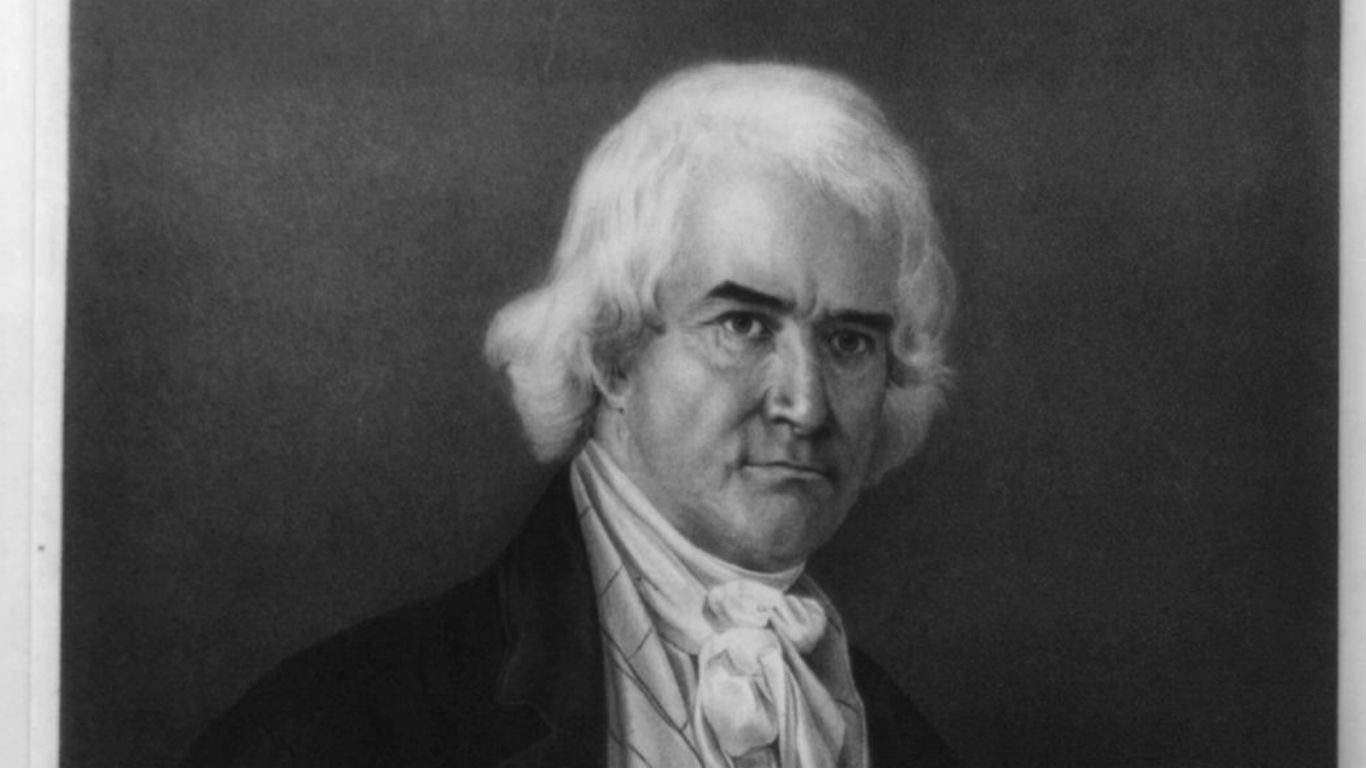
11. George Mifflin Dallas
> Presidential administration(s): James K. Polk
> Year(s) in office: 1845 – 1849
> Party affiliation: Democratic
George Mifflin Dallas served as vice president from 1845 to 1849, during James Polk’s single-term presidency. Dallas was born into an aristocratic Philadelphia family, and his political motivations were partially rooted in a desire for historical fame. Though his personal designs on the presidency were never fulfilled, Dallas was an aggressive expansionist and supported the annexation of Texas. He is the namesake of Dallas, Texas.
Before becoming vice president, Dallas served in the U.S. Senate, representing his home state of Pennsylvania. After leaving the executive branch, he served as a minister to Great Britain.
[in-text-ad]
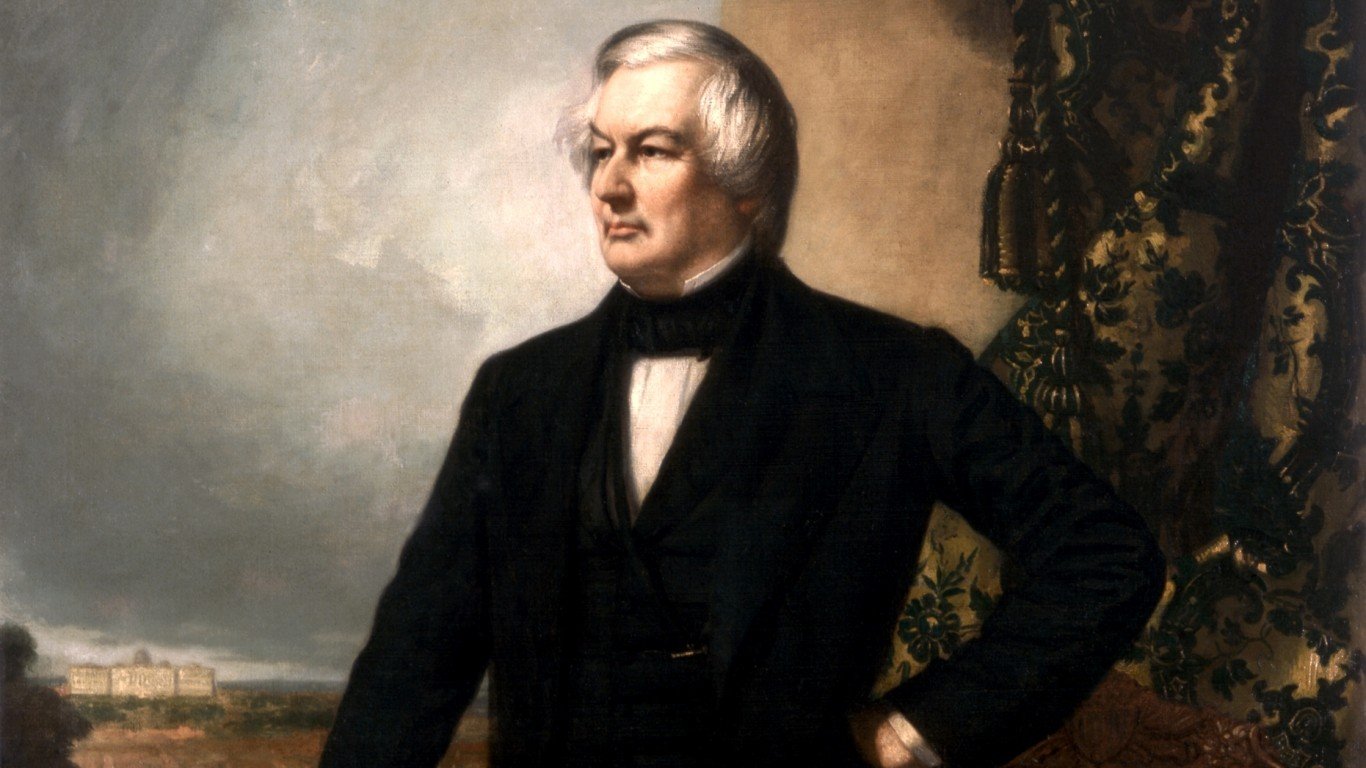
12. Millard Fillmore
> Presidential administration(s): Zachary Taylor
> Year(s) in office: 1849 – 1850
> Party affiliation: Whig
From 1801 to 1901, eight of the nation’s 22 vice presidents came from New York state. This was because the Empire State had the country’s largest congressional contingent, and as such cast the most votes in the Electoral College. Millard Fillmore (1800-1874) was one of these vice presidents.
Fillmore, born in a log cabin and raised on a farm in upstate New York, worked his way up through the Whig Party, becoming a congressman and New York state comptroller before becoming Zachary Taylor’s vice president. While vice president, he dealt with the volatile issue of the admission of Missouri to the Union. Fillmore served as vice president for only 17 months when Taylor died in office in 1850. He then became the country’s 13th president.
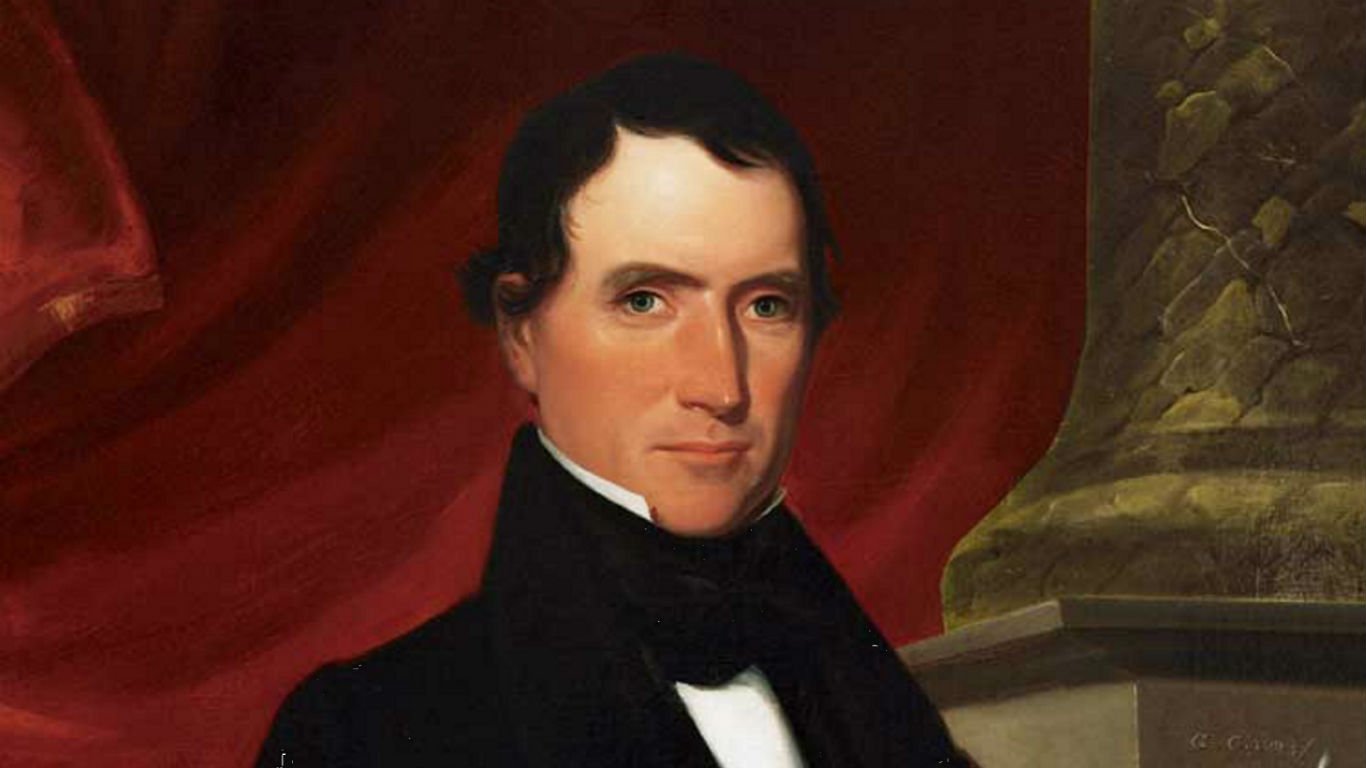
13. William Rufus King
> Presidential administration(s): Franklin Pierce
> Year(s) in office: 1853
> Party affiliation: Democratic
William Rufus King is the only Alabama resident to have served as vice president of the United States. Before becoming vice president, King served in the U.S. Senate, representing Alabama, for nearly 29 years, which at the time, was longer than all but one other senator in the history of the country. He was put on the ticket of presidential candidate and New Hampshire native Franklin Pierce in the hopes that the North/South ticket would appeal to a wide range of voters.
King was ultimately sworn in as vice president in Cuba, while trying to recover from tuberculosis. Less than a month later, he died of the ailment in Selma, Alabama. No one in American history has had a shorter term as vice president. Pierce served the rest of his term with no vice president.
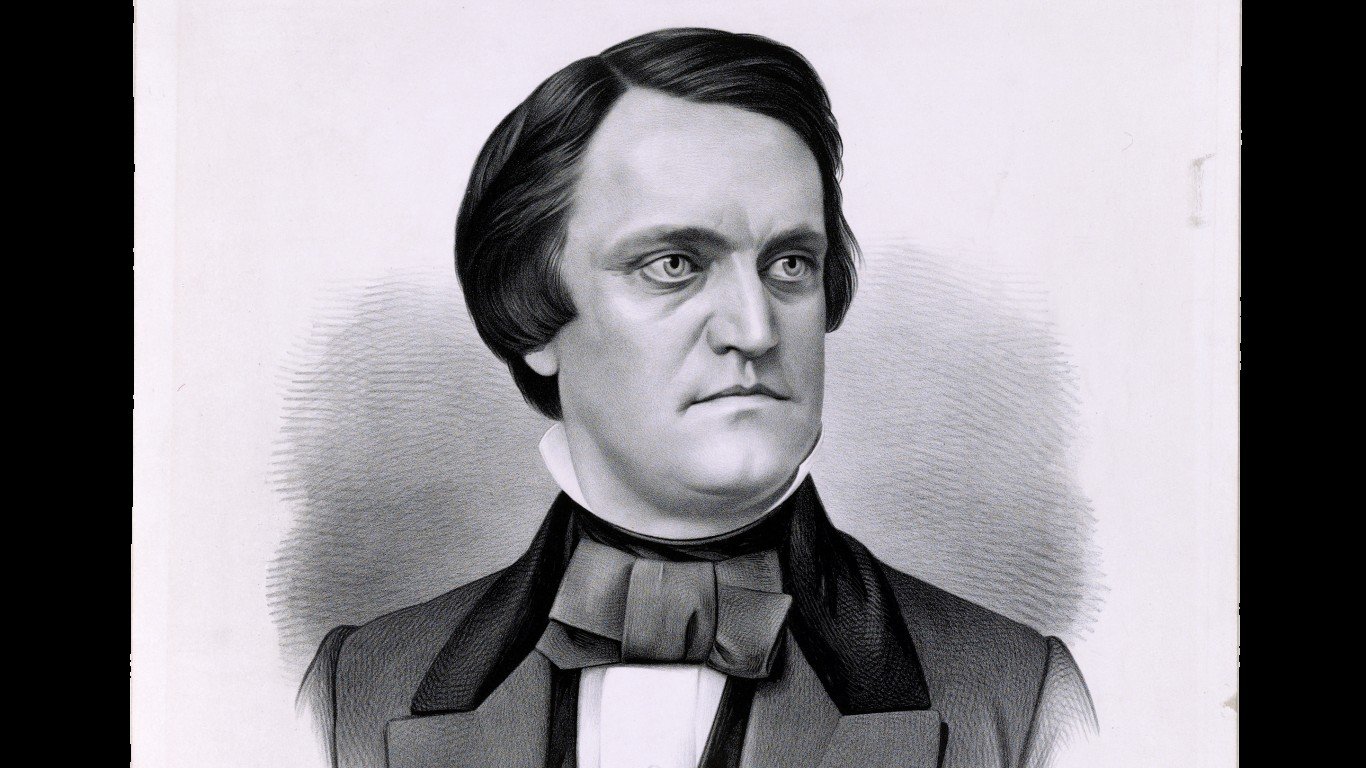
14. John C. Breckinridge
> Presidential administration(s): James Buchanan
> Year(s) in office: 1857 – 1861
> Party affiliation: Democratic
John C. Breckinridge was an eloquent orator with a proslavery stance as congressman from Kentucky. Breckinridge was chosen to serve as vice president with Pennsylvanian President James Buchanan for geographical balance and because his selection would appease powerful Illinois Sen. Stephen A. Douglas, who had worked with Breckinridge on the Kansas-Nebraska Act.
Breckinridge became the nation’s youngest vice president at 36, but he fell out with Buchanan, who saw him as an ally of Douglas. Breckinridge was proslavery, though he was opposed to secession. His tenure as vice president was during a turbulent era in American politics, and he was recognized for his impartiality while presiding over the Senate and his call for national unity. Breckinridge ran for president in 1860 and finished third in a three-person race. Though Kentucky chose to remain in the Union, Breckinridge took up arms against the Union, and was expelled from Congress, which branded him a traitor.
[in-text-ad-2]
15. Hannibal Hamlin
> Presidential administration(s): Abraham Lincoln
> Year(s) in office: 1861 – 1865
> Party affiliation: Republican
Hannibal Hamlin served as vice president of the United States during perhaps the most tumultuous time in U.S. history. Hamlin was added to the ticket of presidential candidate Abraham Lincoln. After their electoral win the Confederate states seceded from the union, and Hamlin’s tenure in the executive branch overlapped with the Civil War.
A native of Maine, Hamlin was selected to be Lincoln’s vice president to add some geographic balance to the ticket and for his anti-slavery, pro-union positions. Ultimately, Hamlin was outspoken about his disregard for his office and his inability to accomplish anything. He observed that he had more power as a senator than as vice president and that the office was a “nullity.” He did, however, offer Lincoln council when it was sought.
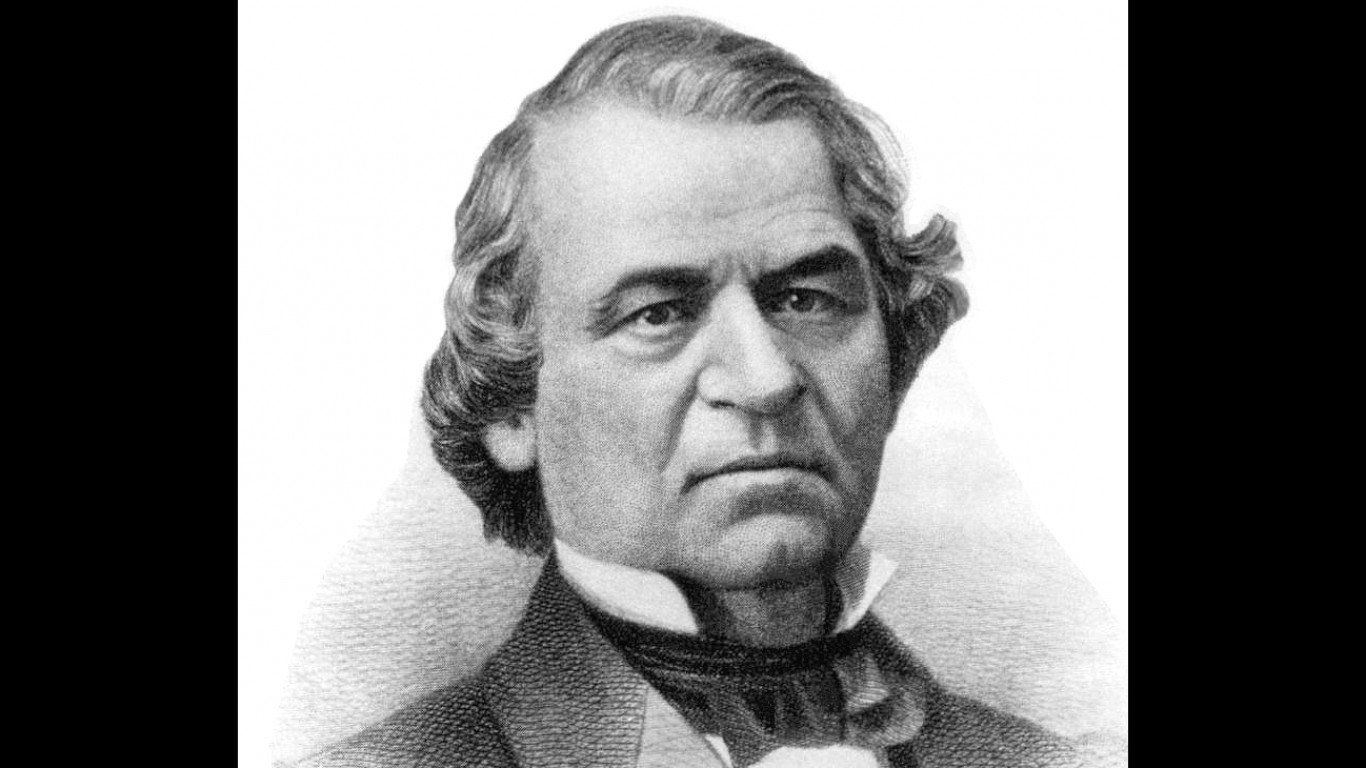
16. Andrew Johnson
> Presidential administration(s): Abraham Lincoln
> Year(s) in office: 1865
> Party affiliation: Democratic
Andrew Johnson was a senator from Tennessee and the only Southern senator to remain loyal to the Union after his state had seceded. President Abraham Lincoln, seeking reelection in 1864, chose Johnson to be his running mate, replacing sitting Vice President Hannibal Hamlin.
Johnson was vice president for just 42 days and became president on April 15, 1865, following the assassination of Lincoln. As president, Johnson ran afoul with the Republicans in Congress over Reconstruction policies after the war, and in 1868, he became the first president to be impeached. He was acquitted by one vote in the Senate.
[in-text-ad]
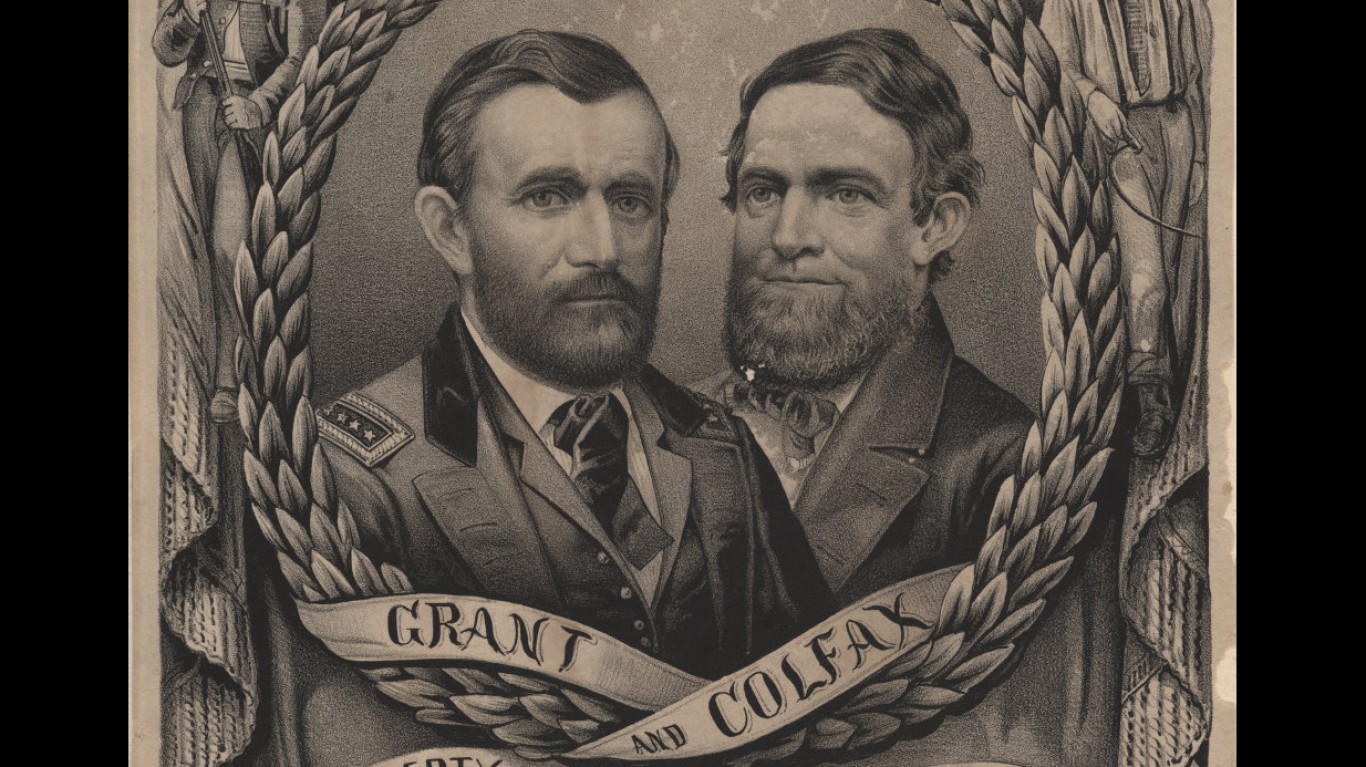
17. Schuyler Colfax
> Presidential administration(s): Ulysses S. Grant
> Year(s) in office: 1869 – 1873
> Party affiliation: Republican
Schuyler Colfax served in the House of Representatives for 15 years, six of which as Speaker of the House, before becoming vice president under Ulysses S. Grant. Colfax was successful in his earlier years in politics due to his ability to get along with people of differing political persuasions and was nicknamed “Smiler” Colfax. This quality ultimately became a liability, however, as many saw it as manipulative and self serving. Colfax was removed by his party from the ticket during Grant’s reelection bid.
Later the same year, Colfax was implicated in a corruption scandal that involved illegal contract practices for the construction of the Union Pacific Railroad. It was later revealed that Colfax had accepted thousands of dollars in campaign contributions from a government contractor.
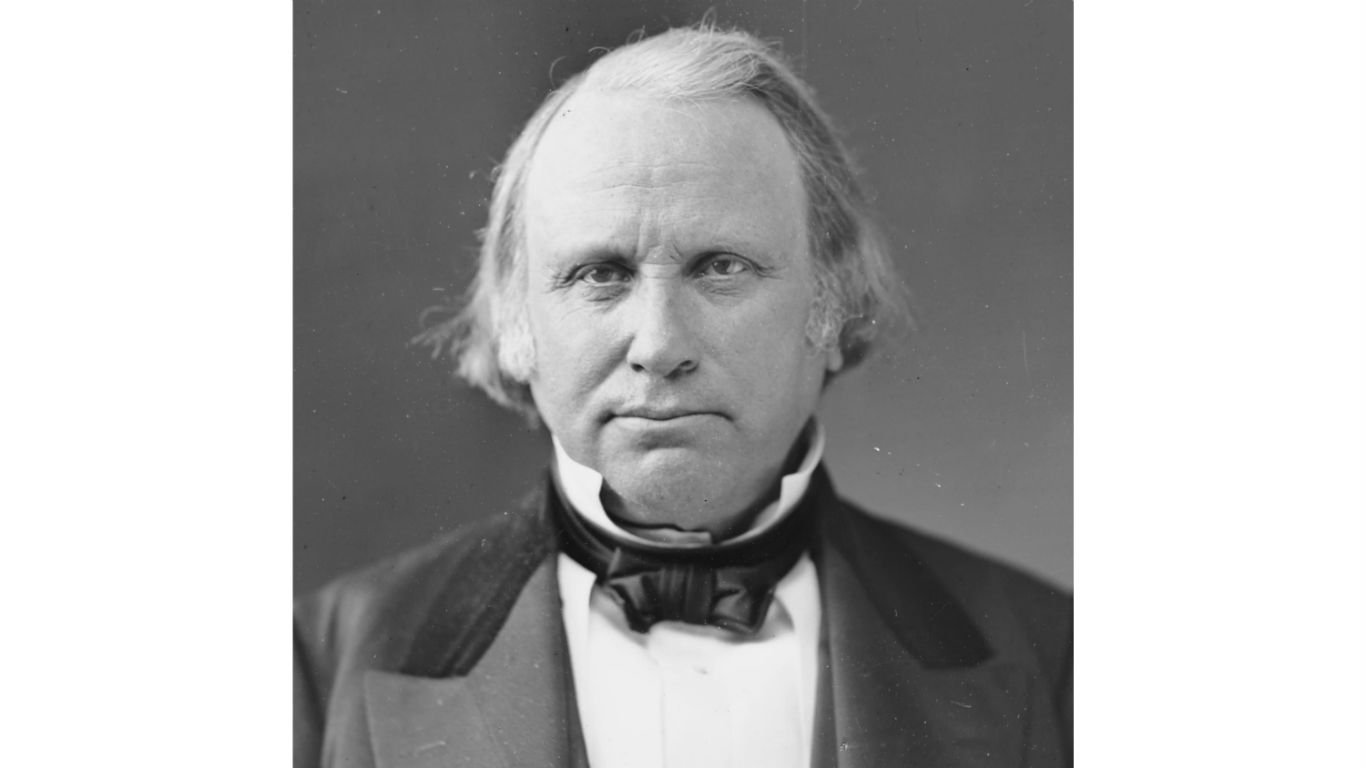
18. Henry Wilson
> Presidential administration(s): Ulysses S. Grant
> Year(s) in office: 1873 – 1875
> Party affiliation: Republican
Henry Wilson was born Jeremiah Jones Colbath to a poor Massachusetts family and changed his name in adulthood. He overcame poverty, became a business owner and later interested in politics. He was a passionate abolitionist and a supporter on women’s right to vote. He served 18 years in the Senate and became known for his ability to read public opinion.
President Ulysses S. Grant picked the ambitious Wilson as vice president for his second term, replacing the sitting VP, Schuyler Colfax. Republican leaders believed Wilson would help Grant with the working class vote. During the 1872 campaign, Wilson was tainted by a scandal in which elected officials were accused of taking railroad stock at reduced or no cost in exchange for backing legislation that would bankroll construction of a transcontinental railroad line. A congressional investigating committee cleared him of the charges. On the campaign trail, Wilson went on a long speaking tour on which he traveled 10,000 miles. The tour took its toll on his health, and he died in 1875, while in office.
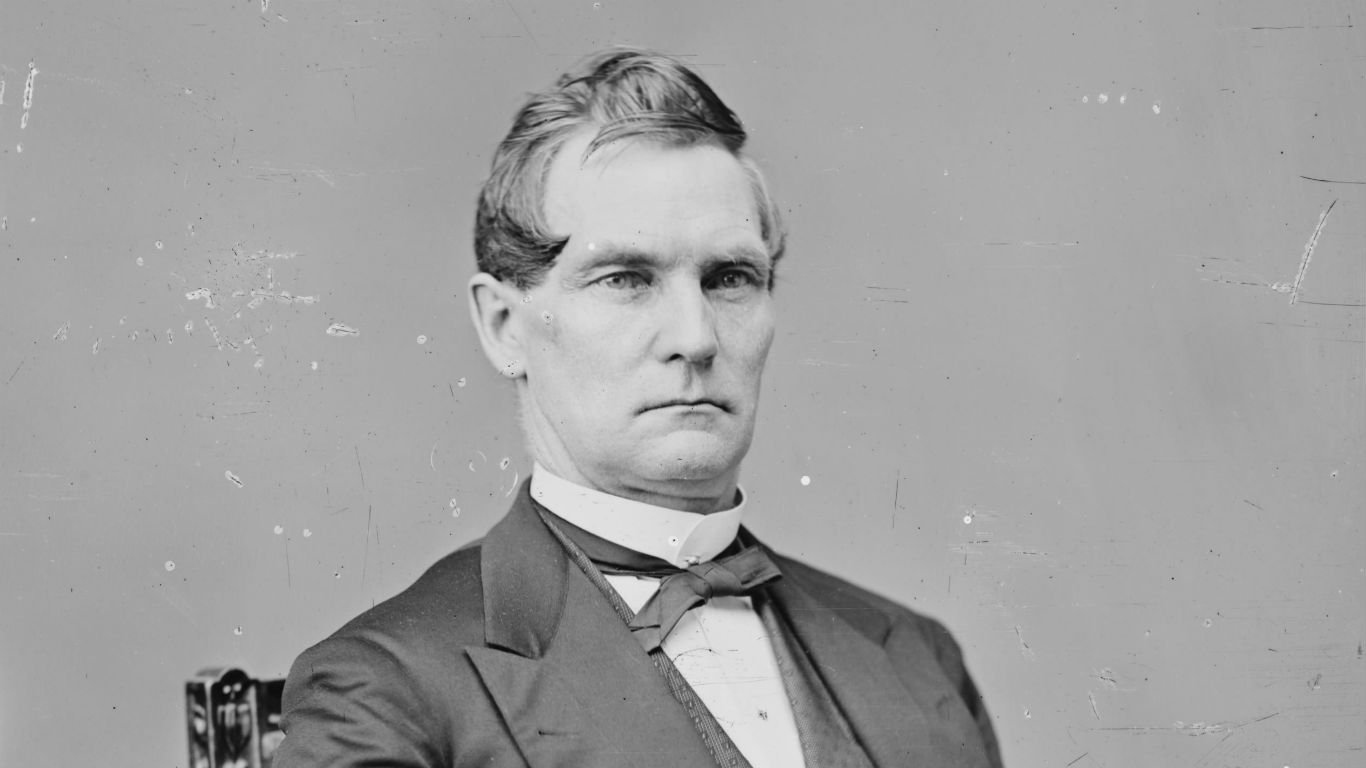
19. William A. Wheeler
> Presidential administration(s): Rutherford B. Hayes
> Year(s) in office: 1877 – 1881
> Party affiliation: Republican
Before becoming vice president to Presidents Rutherford B. Hayes, William A. Wheeler was known in Congress for his honesty and quality of character — attributes that made him an ideal candidate at a time when high profile politicians were being implicated in scandals and public trust was low. Hayes and Wheeler ultimately won the executive office despite not campaigning and a contested election.
Wheeler had little power as vice president but maintained a close personal friendship with Hayes.
[in-text-ad-2]
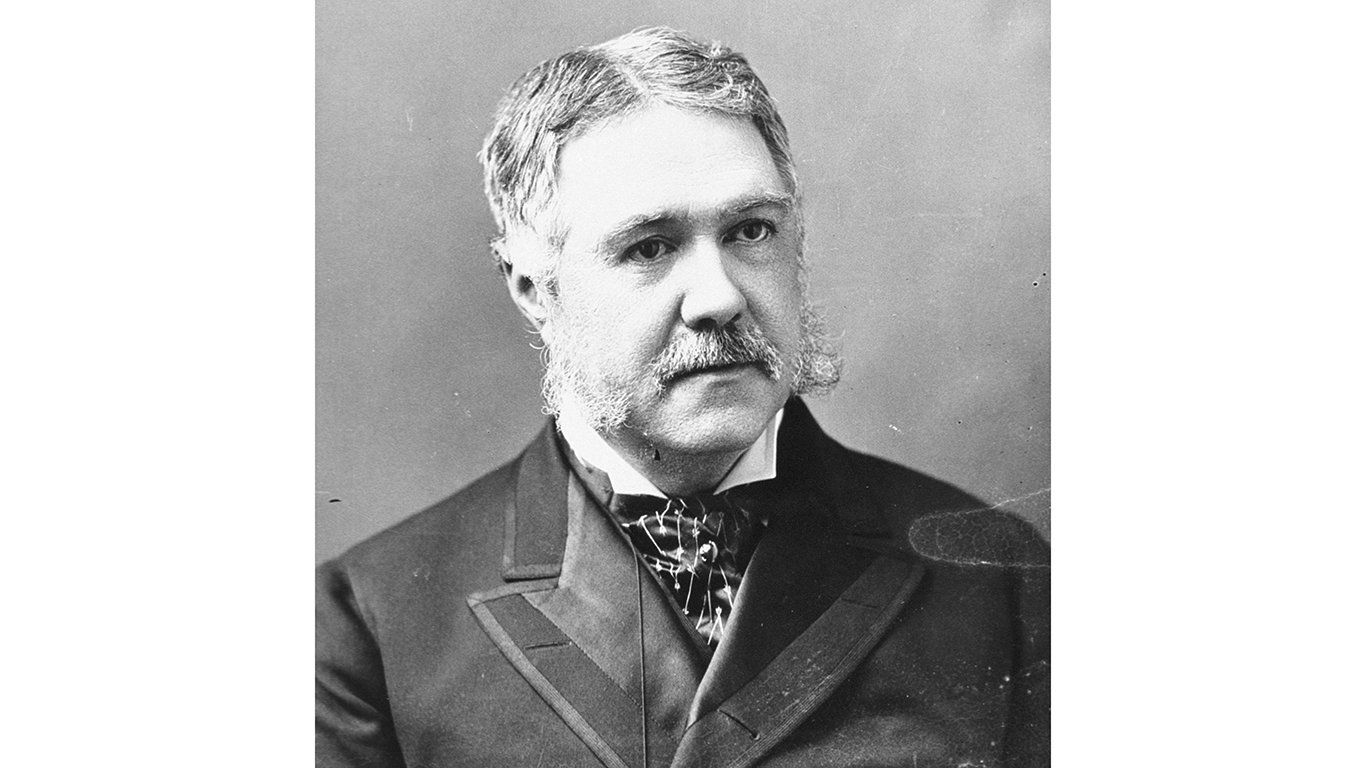
20. Chester A. Arthur
> Presidential administration(s): James A. Garfield
> Year(s) in office: 1881
> Party affiliation: Republican
Chester A. Arthur was another New Yorker who served as vice president. Arthur was connected to the Republican Party political machine led by Sen. Roscoe Conkling that was tied to corruption in civil service in the 19th century. Presidential hopeful James A. Garfield needed a New Yorker on the GOP ticket because of the Empire State’s trove of Electoral College votes, so Arthur was chosen.
Arthur had a reputation as an easy-going man who did the bidding for Conkling, even when he was vice president. Garfield was assassinated in 1881, and Arthur ascended to the presidency after serving as vice president for just 199 days. Arthur turned against his mentor Conkling and embarked on civil service reform.
21. Thomas A. Hendricks
> Presidential administration(s): Grover Cleveland
> Year(s) in office: 1885
> Party affiliation: Democratic
Thomas A. Hendricks was the first vice president to serve in the Grover Cleveland administration. Like many vice presidents who preceded him, Hendricks served in Congress before working in the executive branch, being elected as both a member of the House and the Senate.
Hendricks’s vision for the role of the federal government was often at odds with the views of Cleveland. Hendricks advocated for more government intervention in the economy, while Cleveland was a believer in laissez-faire economics. Hendricks died in his sleep less than one year after being elected vice president.
[in-text-ad]
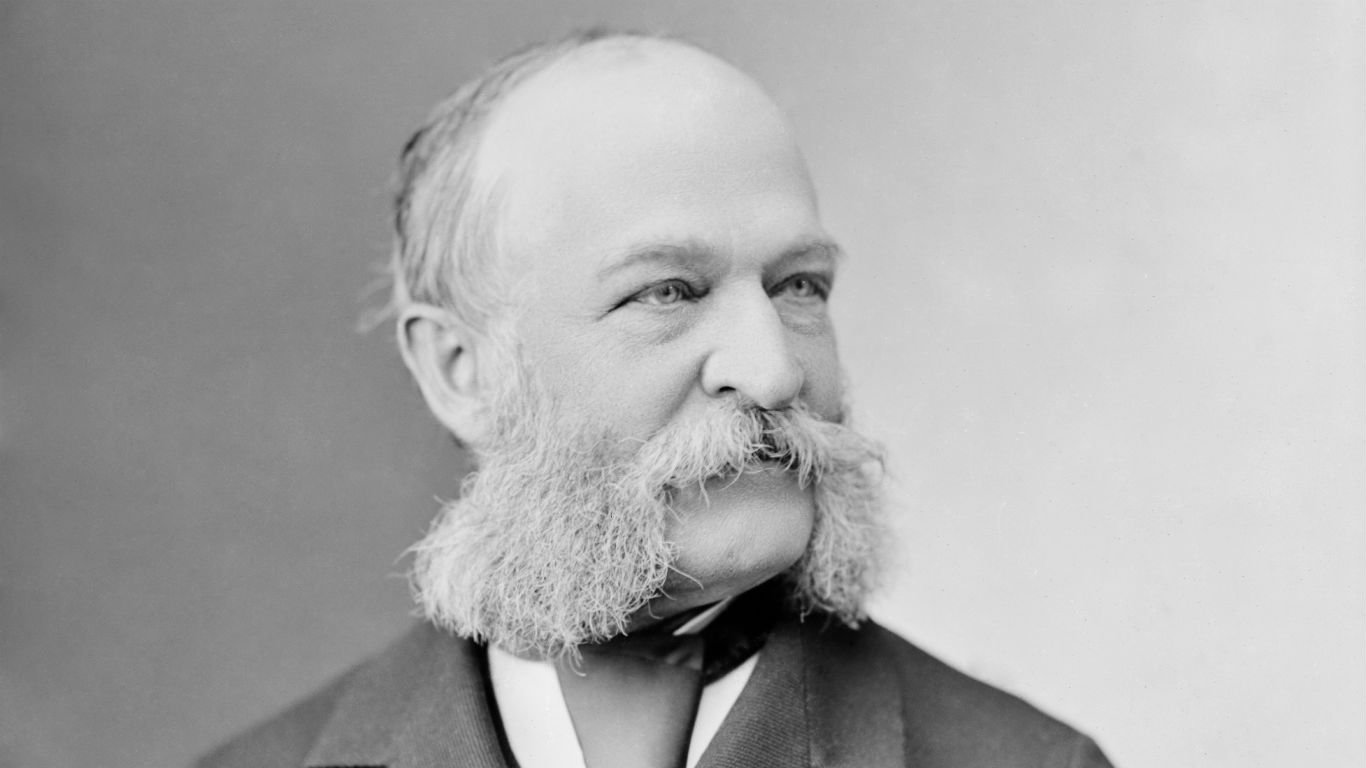
22. Levi P. Morton
> Presidential administration(s): Benjamin Harrison
> Year(s) in office: 1889 – 1893
> Party affiliation: Republican
Known for his gracious manners, Morton was allied with the New York GOP machine, who supported President Ulysses S. Grant. He therefore turned down the VP candidacy offered by presidential candidate James A. Garfield, but later accepted the candidacy offered by Benjamin Harrison, who had the support of the GOP.
Morton became Benjamin Harrison’s vice president. Morton was part of Harrison’s “businessman’s cabinet” but did not distinguish himself as vice president. He remained neutral on a bill that would have supported Black civil rights and the right to vote, much to the chagrin of Harrison. Morton was dropped from the ticket in 1892.
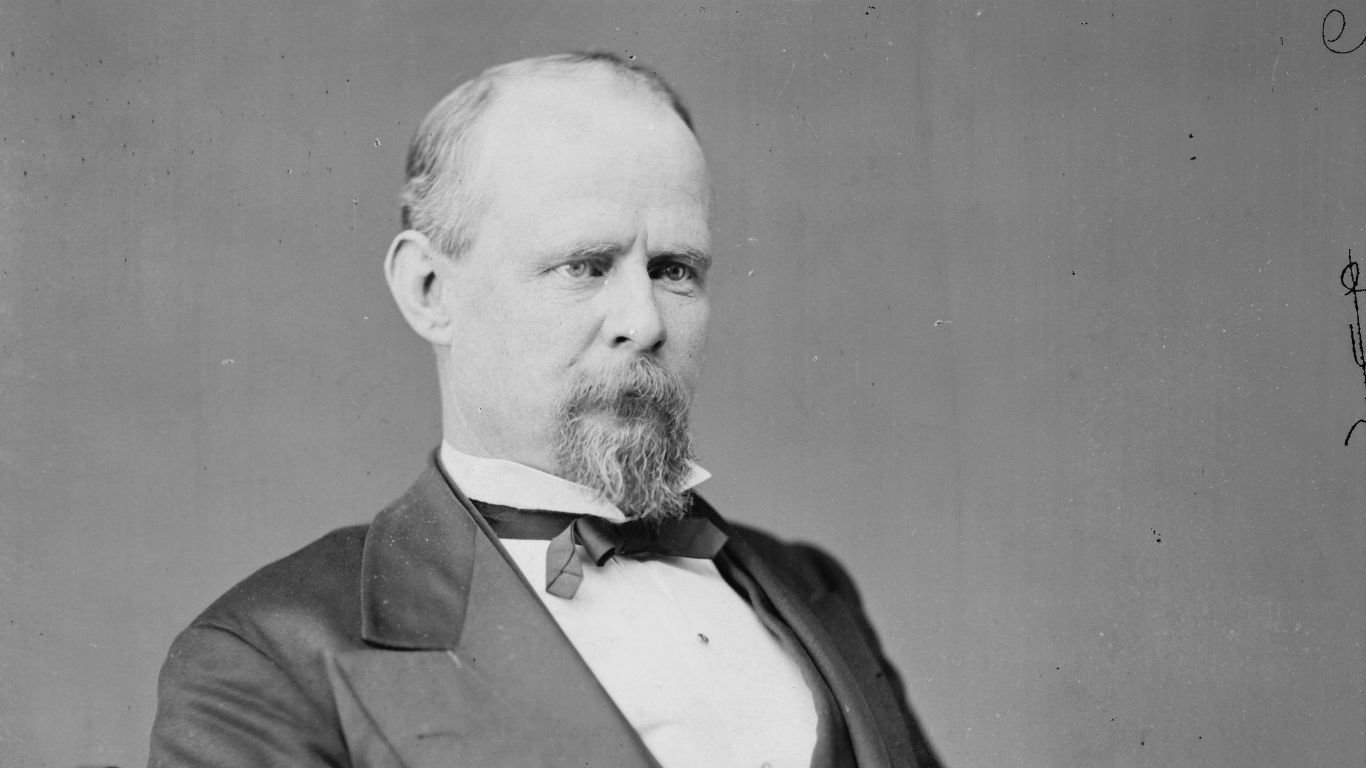
23. Adlai E. Stevenson
> Presidential administration(s): Grover Cleveland
> Year(s) in office: 1893 – 1897
> Party affiliation: Democratic
Adlai E. Stevenson, grandfather of the man who ran for president twice in the 1950s, grew up in Illinois and campaigned for Stephen A. Douglas against Abraham Lincoln in the race for the Senate. Stevenson opposed the nativist platform of the “Know-Nothing” movement and won support among the German and Irish immigrants in Illinois with his storytelling ability and easy-going manner.
Stevenson was chosen as the Democratic VP nominee in 1892 because of his popularity in Illinois, considered a key state for the election hopes of candidate Grover Cleveland. Stevenson’s position on currency reform contrasted with that of Cleveland, who supported the gold standard, and that helped widen the ticket’s appeal. Additionally, his job as assistant postmaster general won him allies in the Democratic Party. Stevenson earned praise for operating his office in a nonpartisan manner.
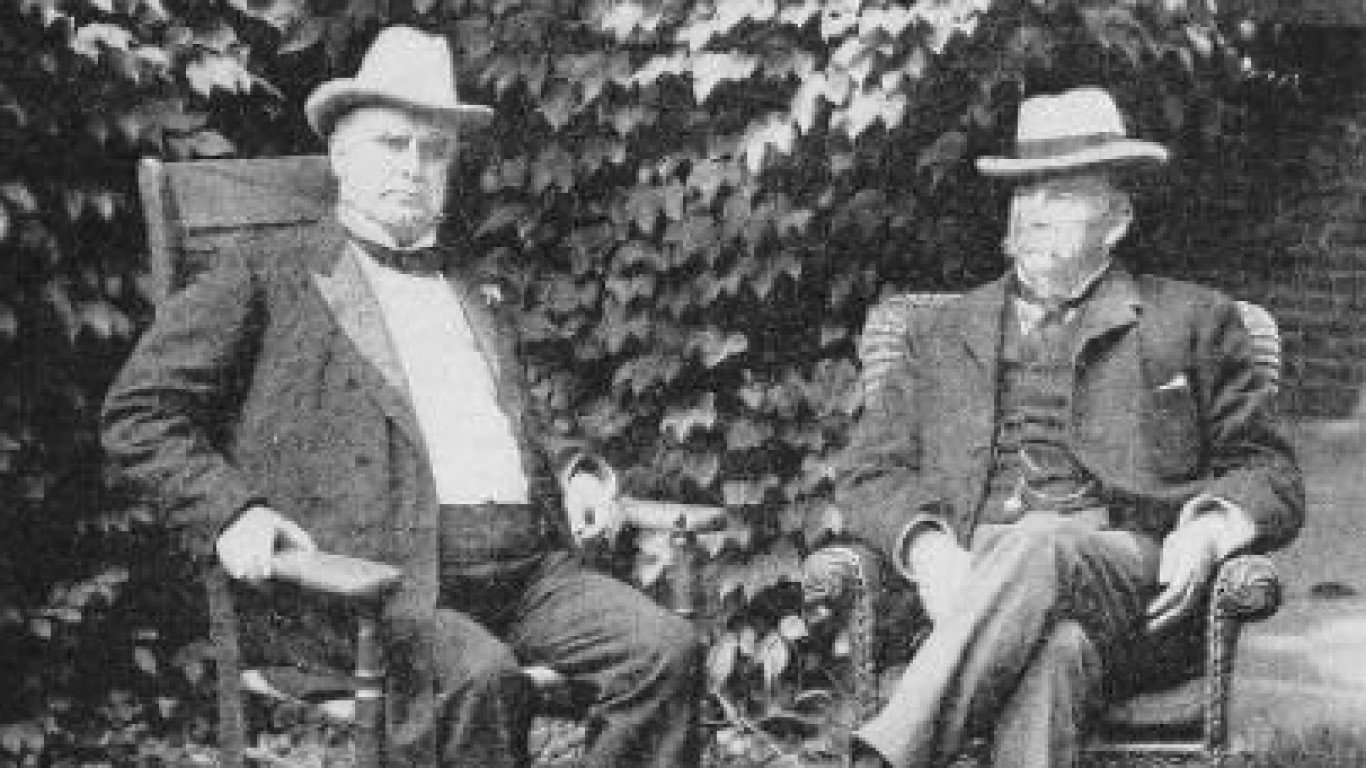
24. Garret A. Hobart
> Presidential administration(s): William McKinley
> Year(s) in office: 1897 – 1899
> Party affiliation: Republican
Garret A. Hobart was an unlikely person to be vice president. The scion of a family of clergymen, Hobart became the first person in New Jersey to lead both houses of the state’s legislature. He was known as an agreeable and tactful man who did not seek the spotlight.
Hobart was chosen by the GOP to geographically balance the ticket with the middle westerner William McKinley. The two were alike in their conservative political philosophy and got along well. McKinley regarded Hobart as a friend and confidant, so much so that Hobart was called the “Assistant President.” Hobart had heart problems that led to his death in November 1899.
[in-text-ad-2]
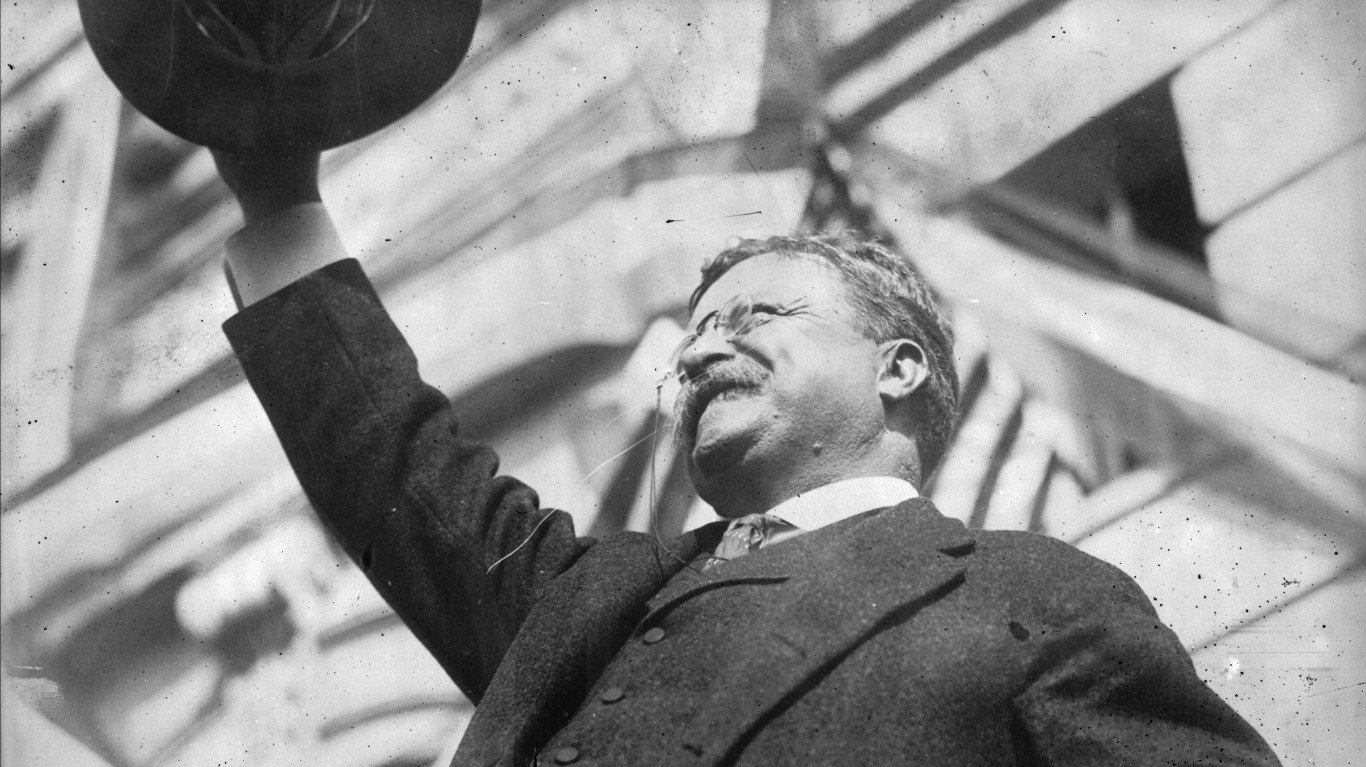
25. Theodore Roosevelt
> Presidential administration(s): William McKinley
> Year(s) in office: 1901
> Party affiliation: Republican
Theodore Roosevelt (1858-1919) played different roles over the course of his life — conservationist, naturalist, cowboy, and soldier among others. One role that he did not relish was vice president, saying that “it [the vice-presidency] is not a stepping stone to anything except oblivion.” His good friend, Massachusetts Sen. Henry Cabot Lodge, aware of Roosevelt’s ambition, felt differently. He believed the VP position would lead Roosevelt to the White House.
Roosevelt was attractive to the GOP because of his Spanish-American War heroism and dynamic personality. Republican delegates at the party convention overwhelmingly chose him to run with President William McKinley. Roosevelt didn’t have to wait long to become president. After a summer of mostly making speeches and showing little interest in the vice presidential job, Roosevelt became president on Sept. 14, 1901, after McKinley was assassinated.
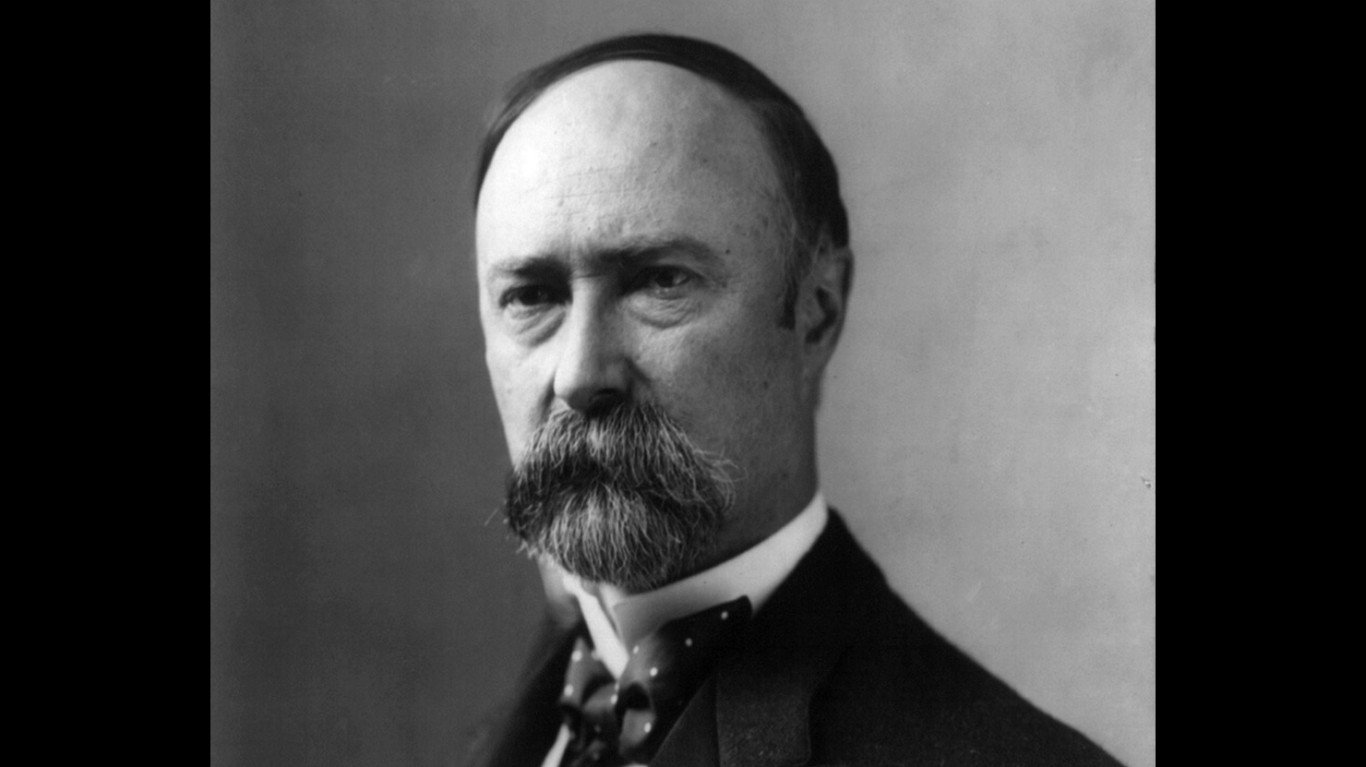
26. Charles W. Fairbanks
> Presidential administration(s): Theodore Roosevelt
> Year(s) in office: 1905 – 1909
> Party affiliation: Republican
Charles W. Fairbanks is sometimes called “the last of America’s log-cabin statesmen” because he grew up in a log cabin in Ohio. Fairbanks built a fortune as a lawyer representing railroad interests and became a powerful Republican senator representing Indiana.
The ambitious Fairbanks wanted to be president and believed becoming vice president would lead to the White House. After the death of powerful GOP figure Mark Hanna in 1904, party leaders approached Fairbanks about running with Theodore Roosevelt as the Republican vice presidential candidate, and he agreed. The ticket was balanced geographically between New York and Indiana, as well as ideologically, with Roosevelt the progressive and Fairbanks the conservative. Before he was president, Roosevelt had advocated for a more activist vice president, but as president, he gave Fairbanks few responsibilities.
[in-text-ad]
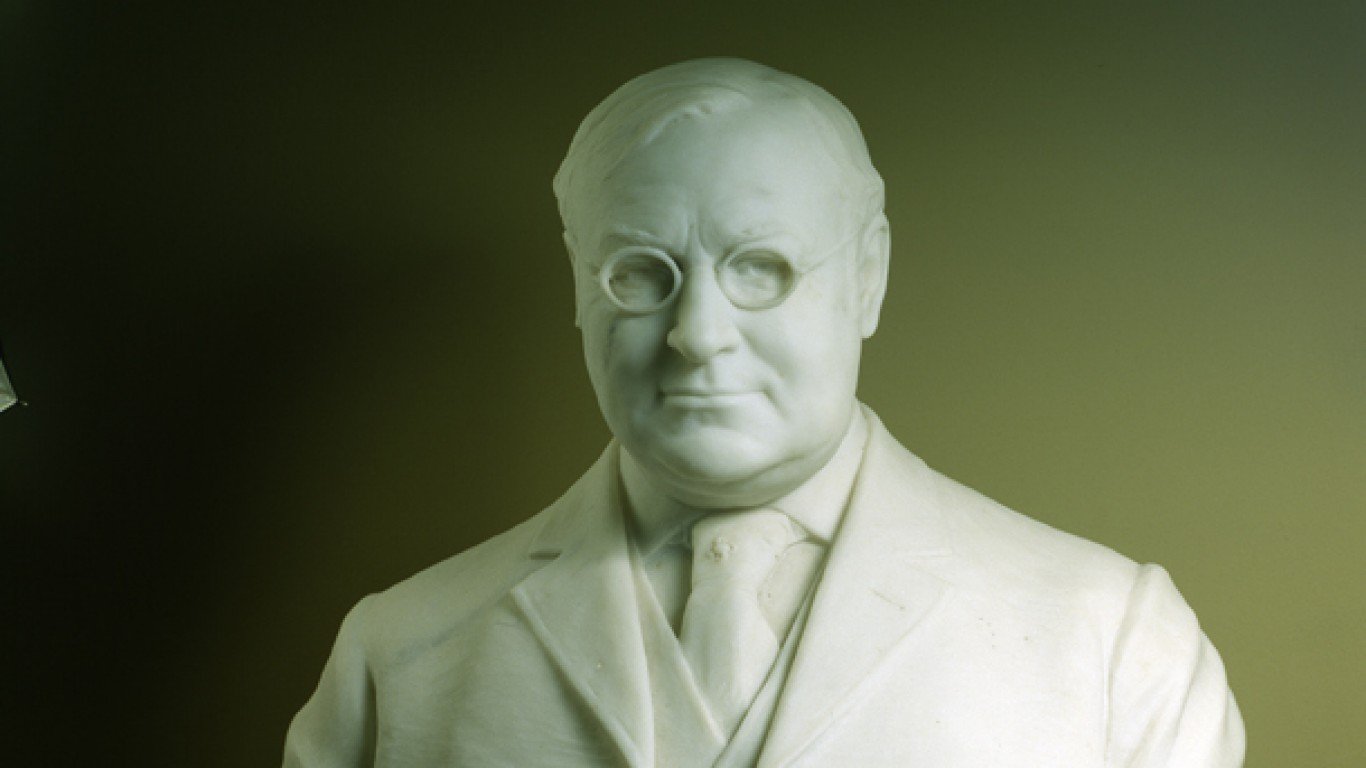
27. James S. Sherman
> Presidential administration(s): William H. Taft
> Year(s) in office: 1909 – 1912
> Party affiliation: Republican
James S. Sherman was in the public sphere all his life, serving 10 terms in the House of Representatives. He was known for his genial manner and ability to manage parliamentary business.
Sherman raised lots of money for GOP candidates and developed supporters and allies. In 1908, President Theodore Roosevelt announced he would not seek a third term, and William Howard Taft became the GOP presidential candidate. Sherman’s supporters launched a vice presidential campaign for him. Though Taft preferred a more progressive candidate, Sherman, a New Yorker, got the nod to balance the westerner (from Ohio) Taft and to placate the conservative wing of the GOP. Sherman and Taft had a good working relationship, and Sherman developed a reputation for fairness and sound judicial temperament.
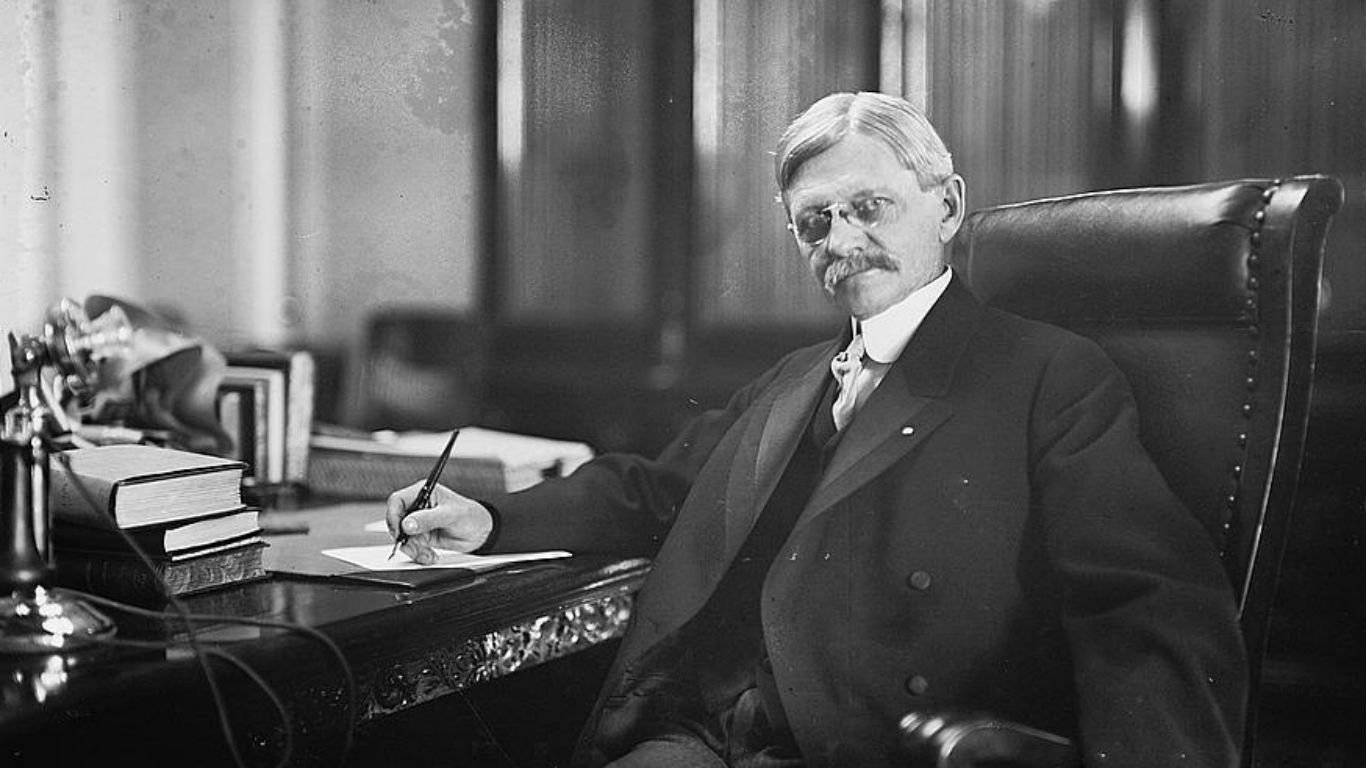
28. Thomas R. Marshall
> Presidential administration(s): Woodrow Wilson
> Year(s) in office: 1913 – 1921
> Party affiliation: Democratic
Thomas Marshall served as vice president during the Woodrow Wilson administration from 1913 to 1921. He was the first person to serve in that capacity for two terms in nearly a century. Though Wilson did not have a particularly high opinion of Marshall, the Democratic party favored him as a nominee because he was well liked as governor of Indiana, which was also a strategic state in the election.
As vice president, Marshall held some controversial opinions, including favoring neutrality during World War I and opposing women’s suffrage, and he was rarely asked to advise the president. When Wilson suffered a stroke and was largely incapacitated for part of his second term, Marshall took over some of his duties but made no major decisions.
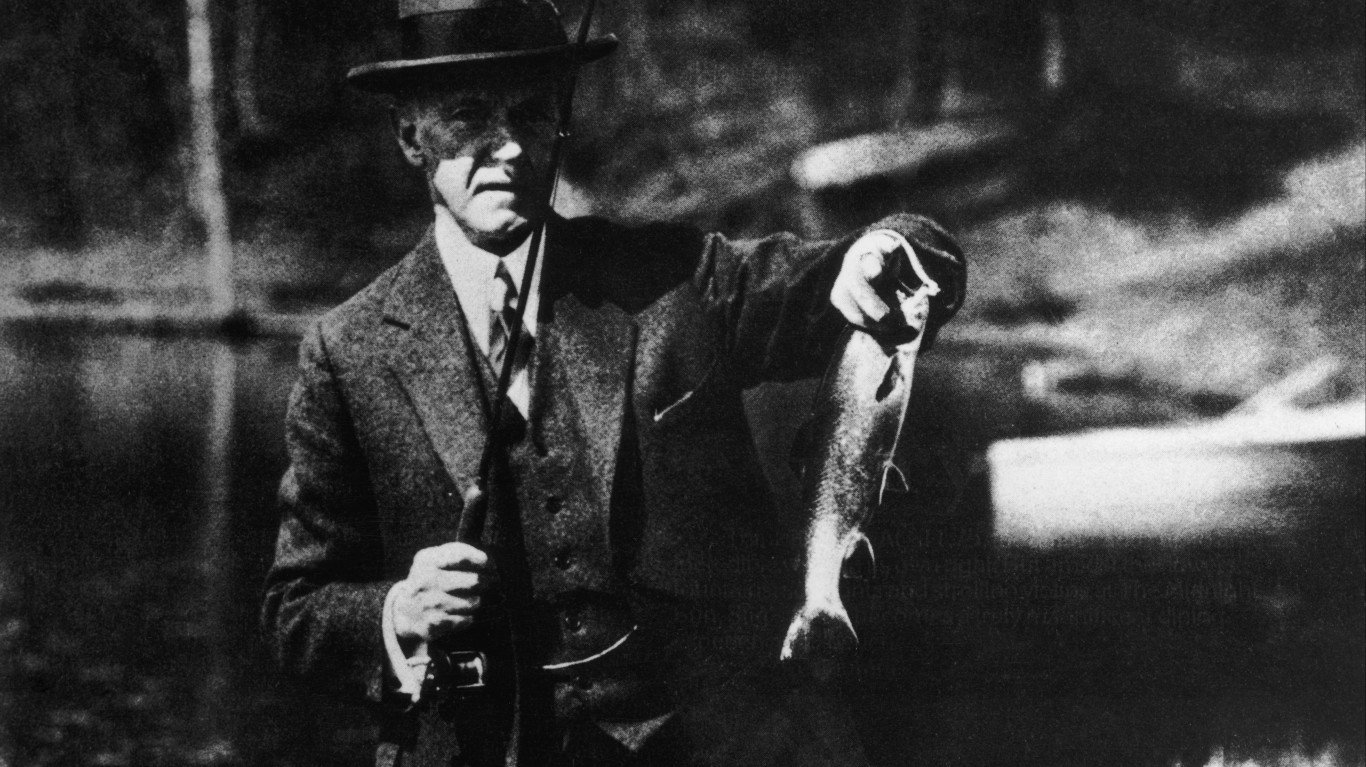
29. Calvin Coolidge
> Presidential administration(s): Warren G. Harding
> Year(s) in office: 1921 – 1923
> Party affiliation: Republican
Personally conservative and quiet, the demeanor of Calvin Coolidge was the antithesis of the boisterous Roaring ’20s during which he was vice president. The Vermont-born Coolidge became VP after serving as governor of Massachusetts, where in 1919 he made national headlines by taking a hard line against Boston’s striking police officers.
Coolidge was considered a presidential hopeful in 1920. Eventually, Warren G. Harding got the nomination. The choice for VP took a while until the GOP settled on Coolidge. Both candidates were ideologically conservative, but that didn’t seem to matter to voters, and the Republicans won in a landslide. Harding invited Coolidge to sit in on regular cabinet meetings, and Coolidge became the first vice president to do so. Coolidge was ill-suited for the personal interaction with other politicians the VP job requires. He became president in 1923 following Harding’s death.
[in-text-ad-2]
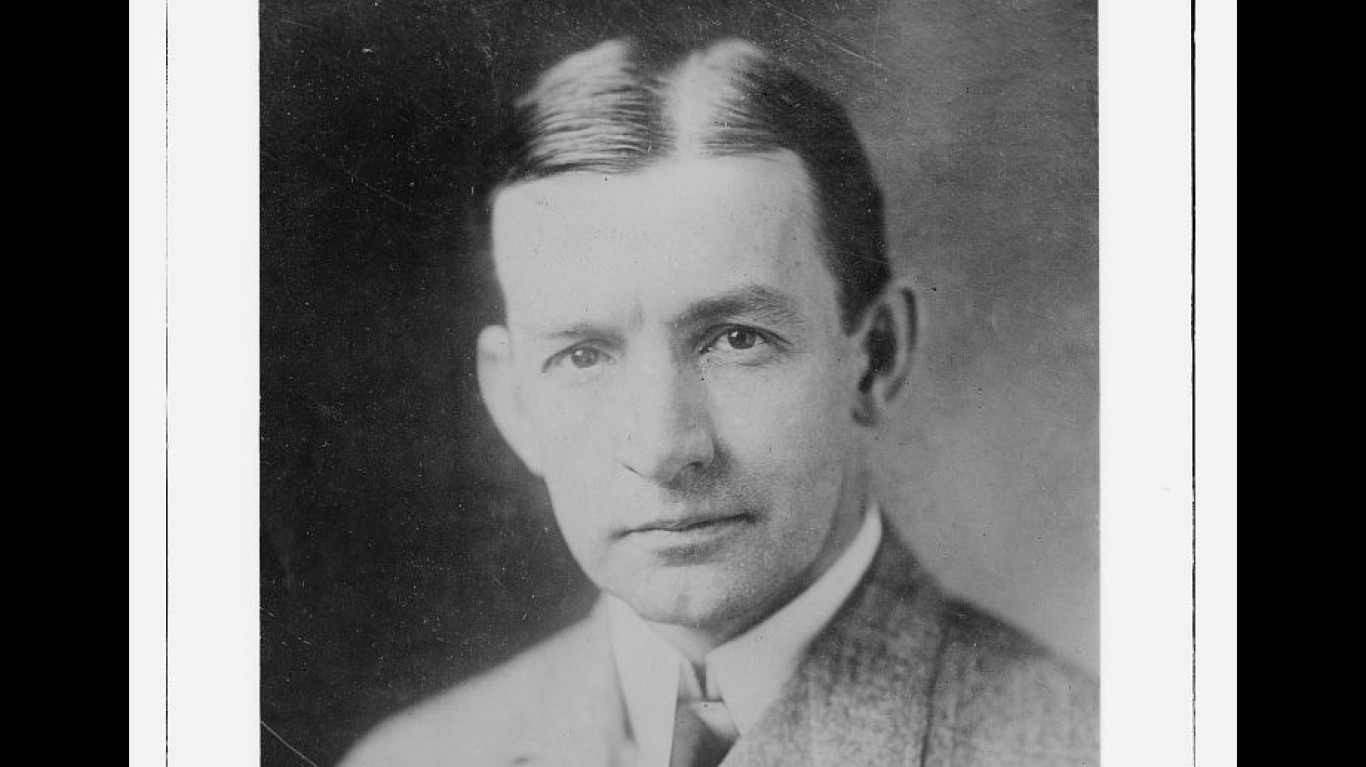
30. Charles G. Dawes
> Presidential administration(s): Calvin Coolidge
> Year(s) in office: 1925 – 1929
> Party affiliation: Republican
Before serving as vice president under Calvin Coolidge through much of the second half of the 1920s, Charles Dawes was in charge of supply procurement for the American Expeditionary Force in France during World War I. Following the end of the war, Dawes presided over a committee that decided on how to help Germany pay reparations for its role in the war. The deliberations resulted in The Dawes Plan, which was credited with saving Europe from economic collapse and also earned the future vice president a Nobel Peace Prize.
Unlike the president, known by many as Silent Cal, Dawes was known for being especially talkative. He never established an effective working relationship with the president. Following his tenure in the executive branch, Dawes went on to serve as U.S. Ambassador to Great Britain.
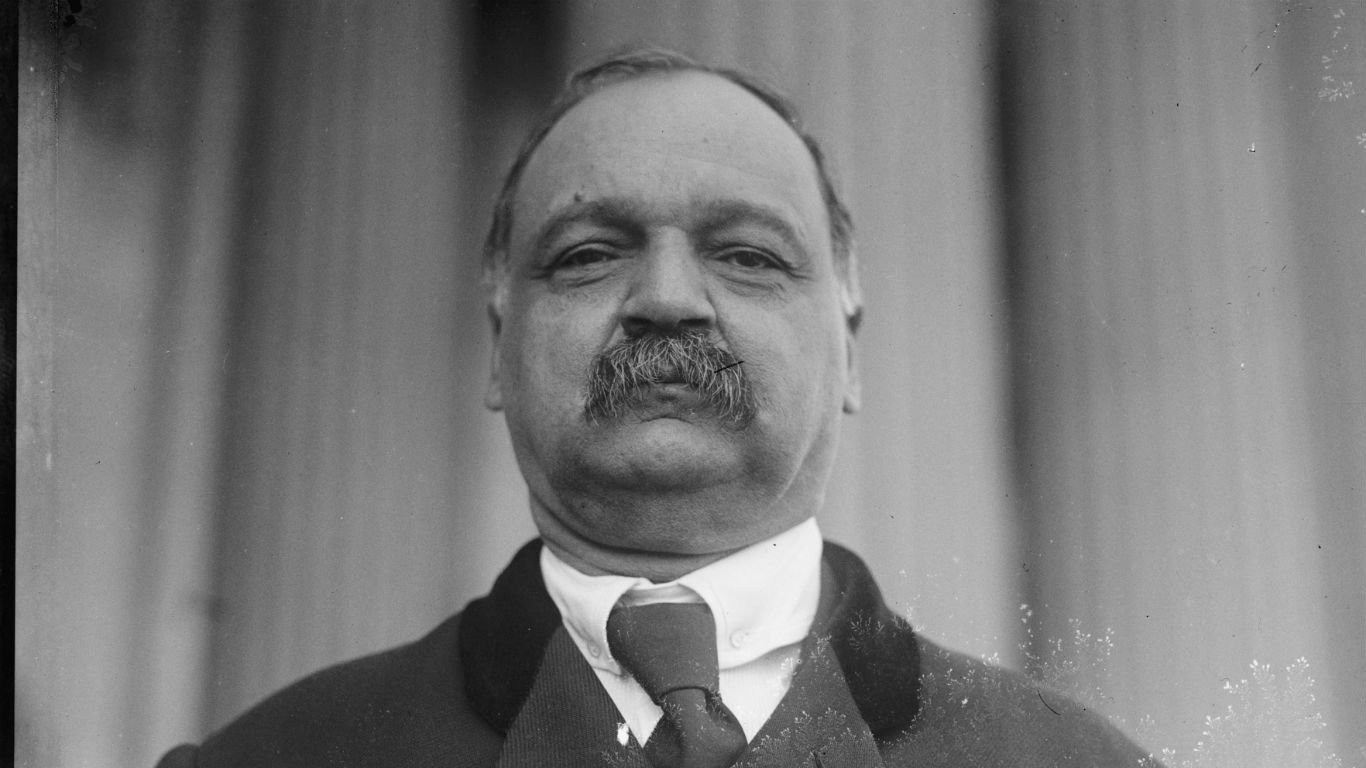
31. Charles Curtis
> Presidential administration(s): Herbert C. Hoover
> Year(s) in office: 1929 – 1933
> Party affiliation: Republican
Charles Curtis (1860-1936) grew up on the Kansas frontier and spoke French and the Native American language Kansa before he learned English. He entered politics and developed a reputation as an engaging speaker who could charm a hostile audience. He built a strong constituency by making it a point to remember people’s names, and he served in the House and Senate from 1893 to 1929.
Herbert Hoover won the nomination for president in 1928, despite objections from farmers. To balance the ticket, Republicans turned to Curtis, from the farm state of Kansas. Curtis was never close to Hoover, and the president did not seek his counsel, despite Curtis’s congressional experience that included a stint as Senate majority leader.
[in-text-ad]
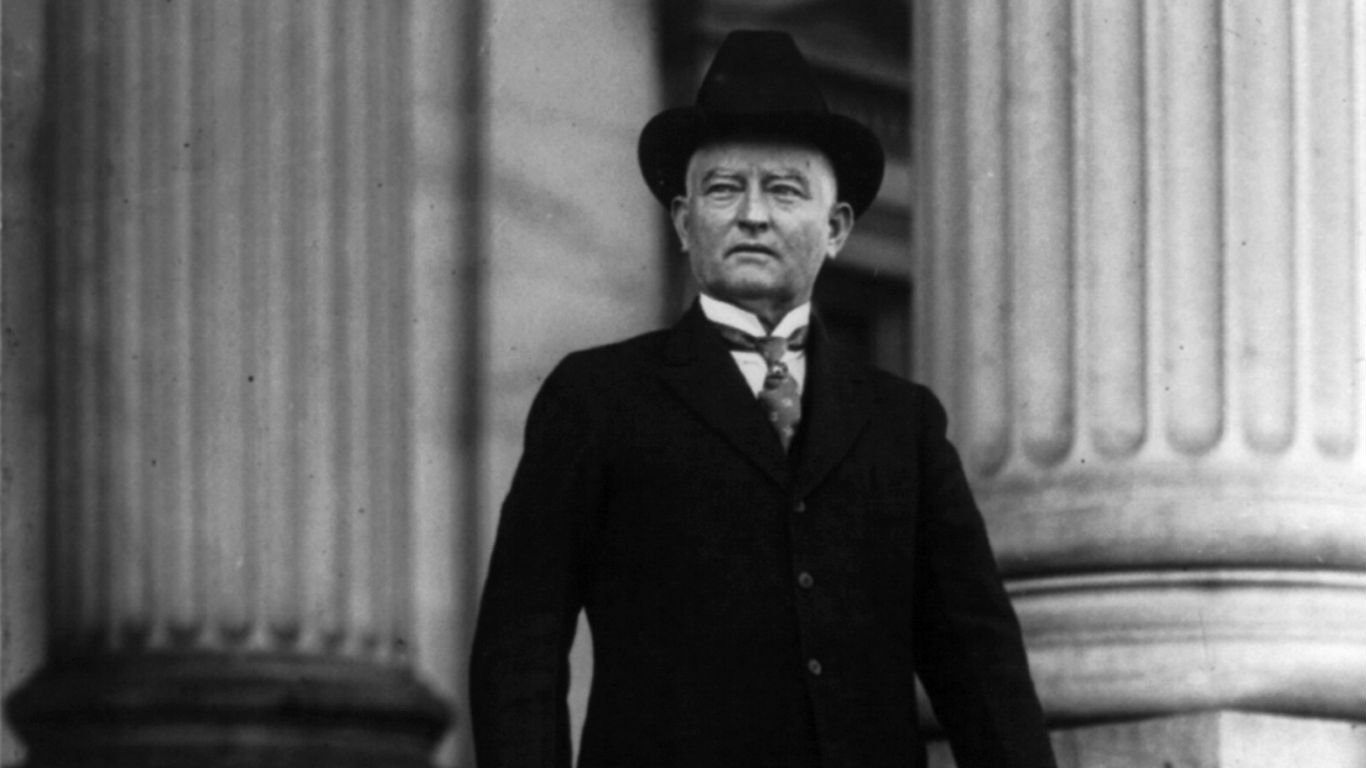
32. John Nance Garner
> Presidential administration(s): Franklin Roosevelt
> Year(s) in office: 1933 – 1941
> Party affiliation: Democratic
John Nance Garner, known as “Cactus Jack” because of his Texas background, served in the House of Representative for 30 years, developing the skills of an expert backroom power broker. Franklin Roosevelt liked his gift for common sense and pragmatism, and Garner represented the more conservative side of the Democratic Party that counterbalanced the New Dealers.
Garner’s familiarity with the mechanics of Congress was an asset for Roosevelt, but Garner was philosophically opposed to the New Deal. He also made no secret of his distaste for the job of vice president, famously saying the office was “not worth a bucket of warm spit.”
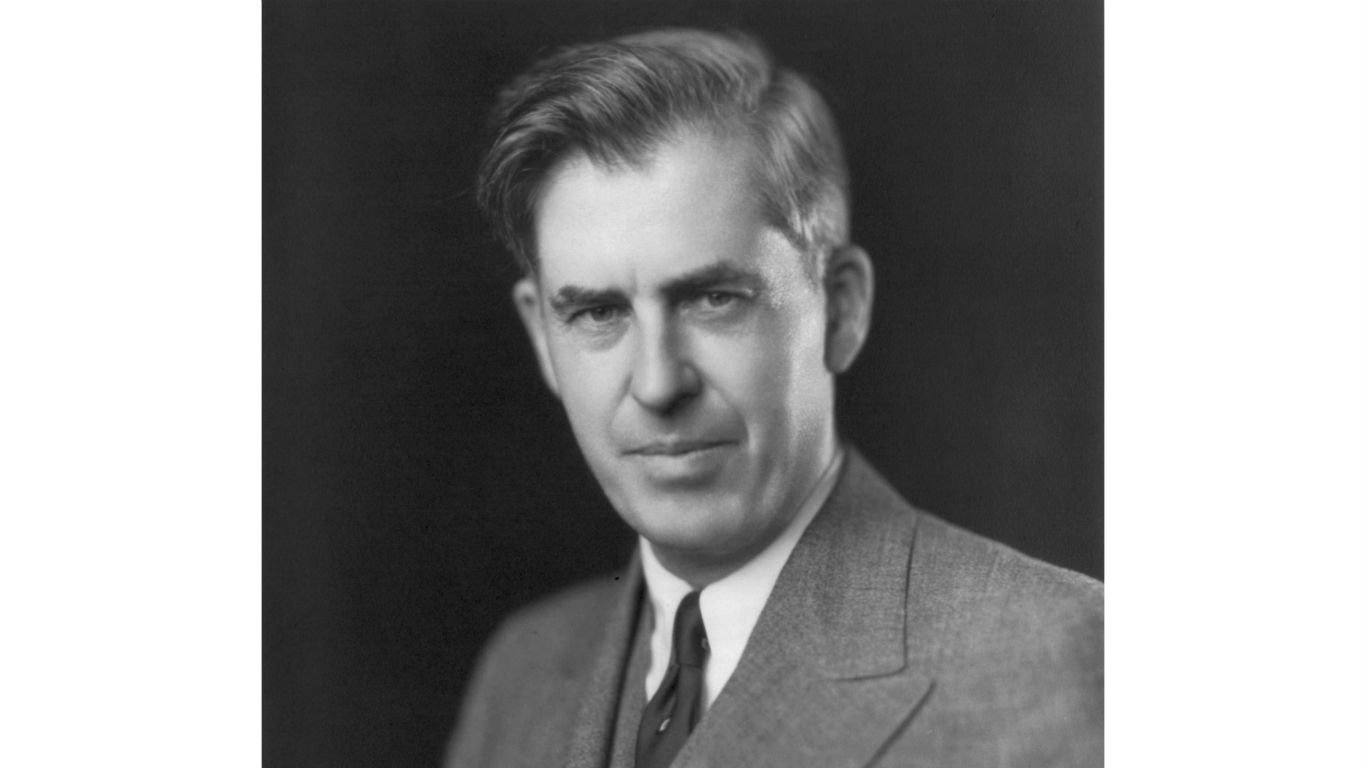
33. Henry A. Wallace
> Presidential administration(s): Franklin Roosevelt
> Year(s) in office: 1941 – 1945
> Party affiliation: Democratic
Iowa-born Henry A. Wallace served as Franklin Roosevelt’s secretary of agriculture and was a champion of New Deal policies that helped farmers recover during the Depression. Wallace was highly regarded by FDR and he was considered in political circles to be a successor to Roosevelt. The president selected him as vice president, and with America on the brink of entering World War II, Wallace was put in charge of economic planning. He was also an emissary for the president on goodwill missions.
Wallace was opposed to machine-style politics and was perceived as aloof. Wallace also ran afoul with Roosevelt’s secretary of commerce over wartime production, and FDR detested squabbling during wartime. Some political circles were also wary of Wallace’s perceived friendliness toward the Soviet Union. He was dropped from the ticket for Roosevelt’s fourth term.
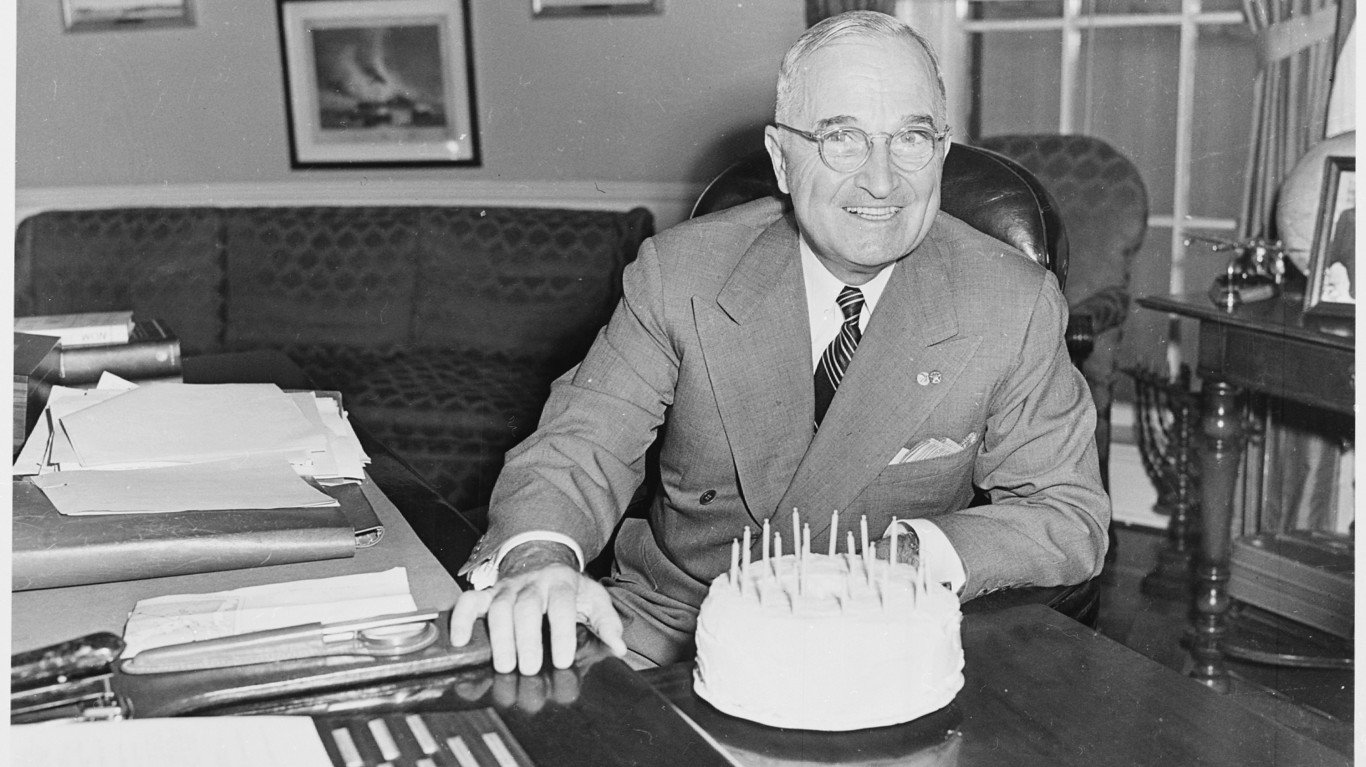
34. Harry S. Truman
> Presidential administration(s): Franklin Roosevelt
> Year(s) in office: 1945
> Party affiliation: Democratic
Harry S. Truman was arguably the most famous accidental president in U.S. history, becoming the chief executive fewer than three months after he was sworn as vice president. Truman became president upon the death of Franklin Roosevelt on April 12, 1945. He had succeeded Henry Wallace as vice president because Wallace had fallen out of favor with party leaders and because Truman, a senator from Missouri, had no known enemies and was somewhat of an independent.
Truman knew little about the building of an atomic weapon during his brief tenure as vice president. To make sure future vice presidents would not be kept in the dark about national secrets, Truman backed the National Security Act of 1947 that gave the VP a place on the National Security Council.
[in-text-ad-2]
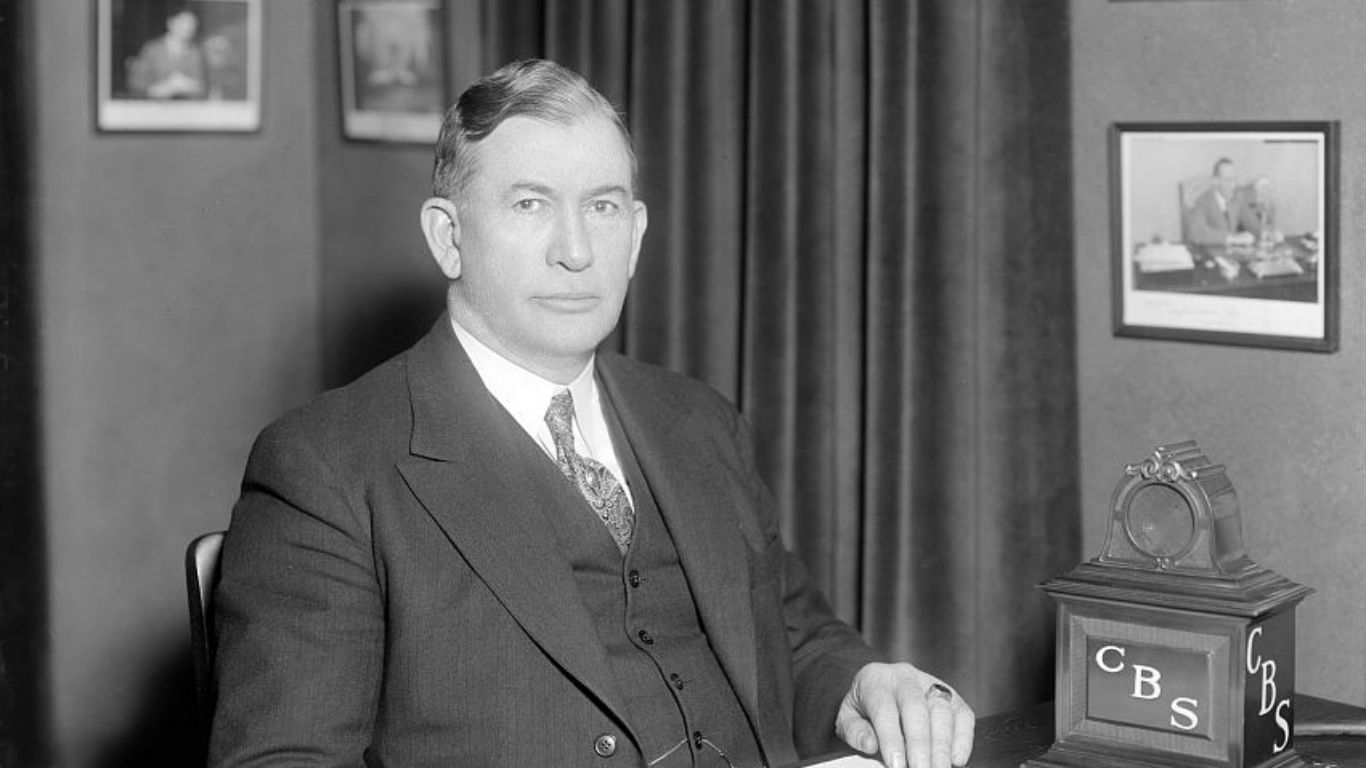
35. Alben W. Barkley
> Presidential administration(s): Harry Truman
> Year(s) in office: 1949 – 1953
> Party affiliation: Democratic
Alben W. Barkley was a genial, grandfatherly figure from Kentucky who was among the most-liked of vice presidents and the oldest. Barkley became a U.S. congressman in 1912 at 35 and stayed in Washington for 42 years. Infused with the idealism of Woodrow Wilson and willing to embrace social and economic programs, Barkley was a New Deal Democrat before Roosevelt became president.
Barkley wasn’t Harry Truman’s first choice for vice president because of his age (he was in his 70s), and his Kentucky background didn’t offer much geographical diversity since Truman was from Missouri. But Barkley’s nomination speech lifted his standing, and he became the VP candidate. Barkley knew how to exercise influence over legislation and how to work with Congress. Truman and Barkley were similar ideologically and socially and got along well.
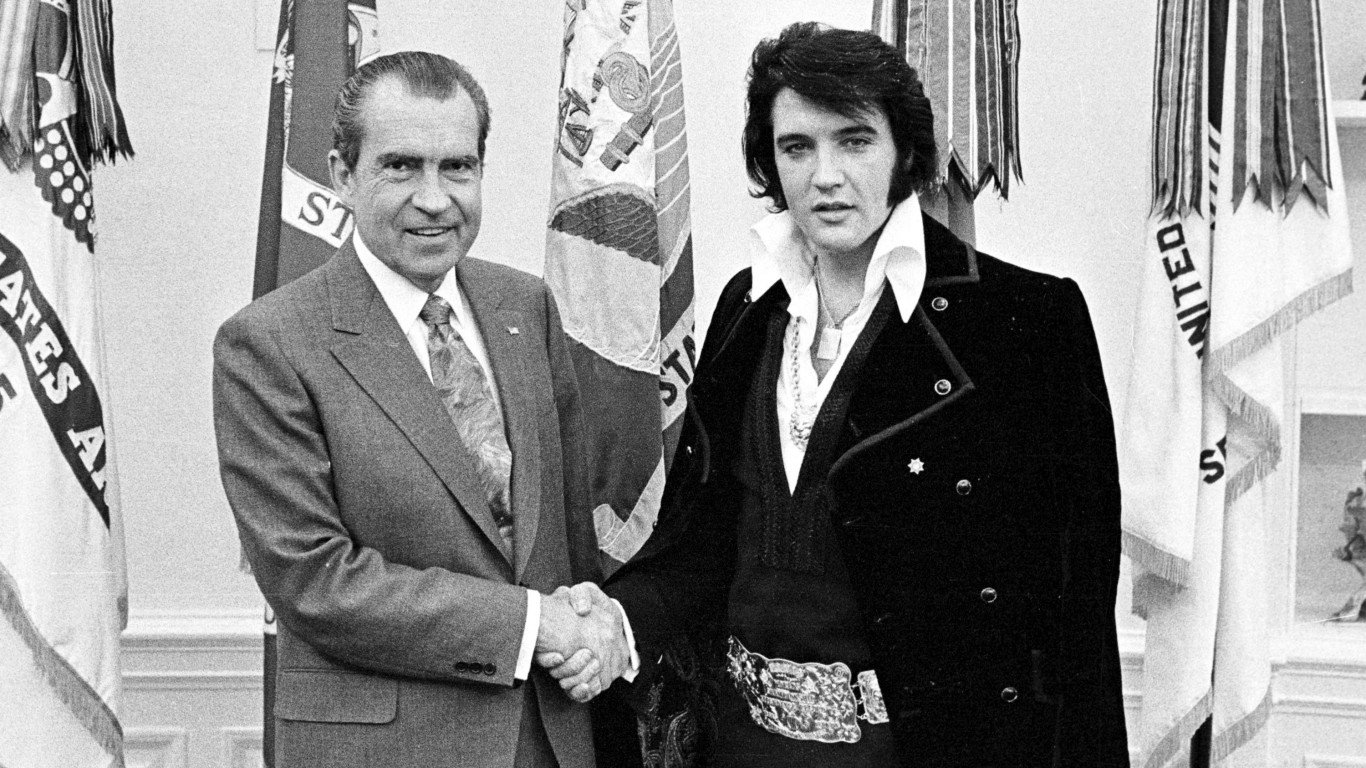
36. Richard M. Nixon
> Presidential administration(s): Dwight Eisenhower
> Year(s) in office: 1953 – 1961
> Party affiliation: Republican
Richard M. Nixon became nationally known as a rabid anticommunist while serving in Congress in the late 1940s and early 1950s. That got the attention of Republican Party presidential candidate Dwight Eisenhower, who believed the Californian could help the GOP ticket in the West. The Republicans won easily in 1952.
Nixon would become a consequential vice president. Eisenhower suffered from heart trouble that impaired his ability to carry out his duties. Concerned about his precarious health, Eisenhower acted to formalize the powers and responsibilities of the vice president in the event that a president became incapacitated. Nixon also took many goodwill tours on the president’s behalf to other countries that raised his profile. He ran for president in 1960 and lost but was elected in 1968. His career ended ignominiously in 1974 when he became the only person to have resigned as president of the United States.
[in-text-ad]
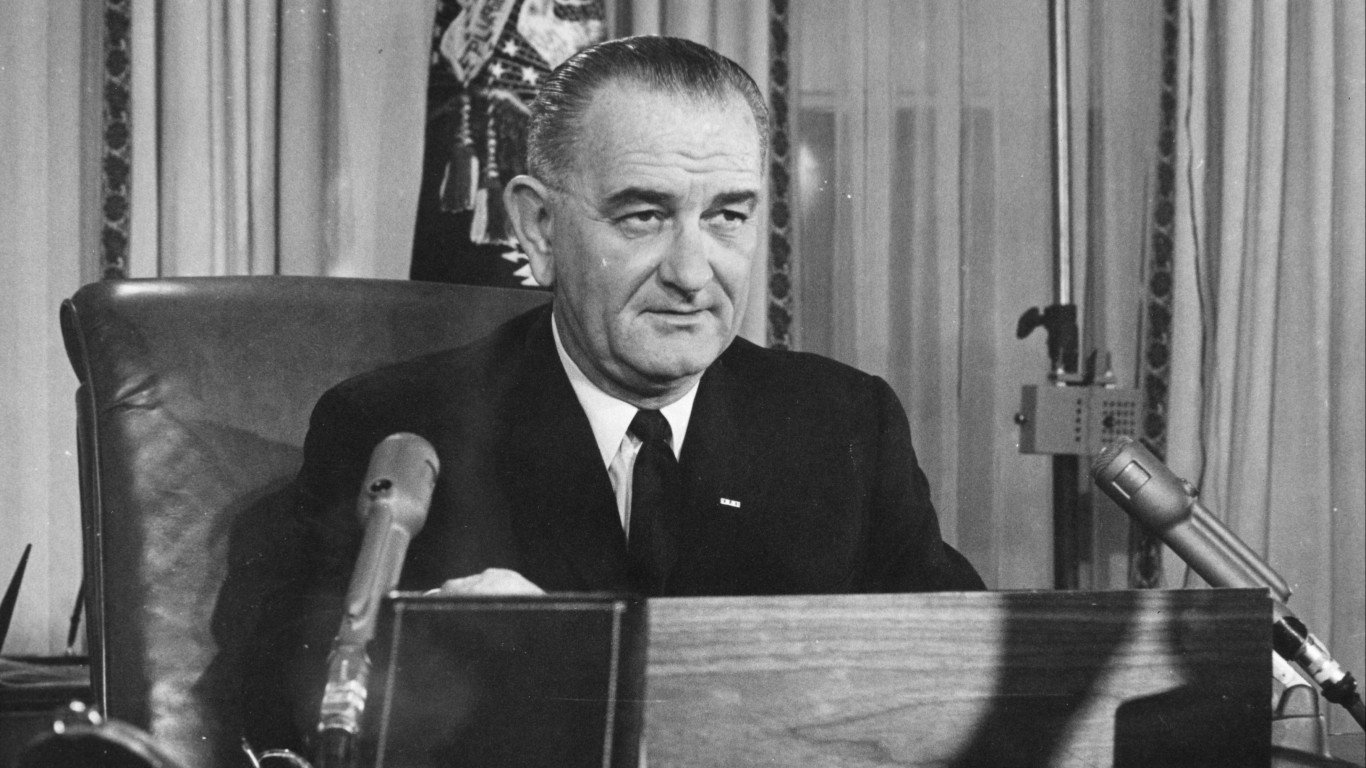
37. Lyndon B. Johnson
> Presidential administration(s): John Kennedy
> Year(s) in office: 1961 – 1963
> Party affiliation: Democratic
Lyndon B. Johnson of Texas built a formidable reputation as a skilled legislator and master negotiator whose powers of persuasion became known as the “Johnson Treatment.” He served six terms in the House and was elected to the Senate in 1948. Five years later, he became the youngest minority leader in Senate history, and in 1954, when the Democrats won control of the Senate, he became majority leader.
John Kennedy picked Johnson to help him win Texas and the South. Their personalities could not have been more different — Kennedy was rich, urbane, and youthful, while Johnson was boisterous and bullying. Kennedy made Johnson chairman of the Space Council and sent the VP on goodwill tours. Generally, however, Johnson had little influence as VP. He became president in 1963 after Kennedy was assassinated and pushed the landmark Civil Rights Act.
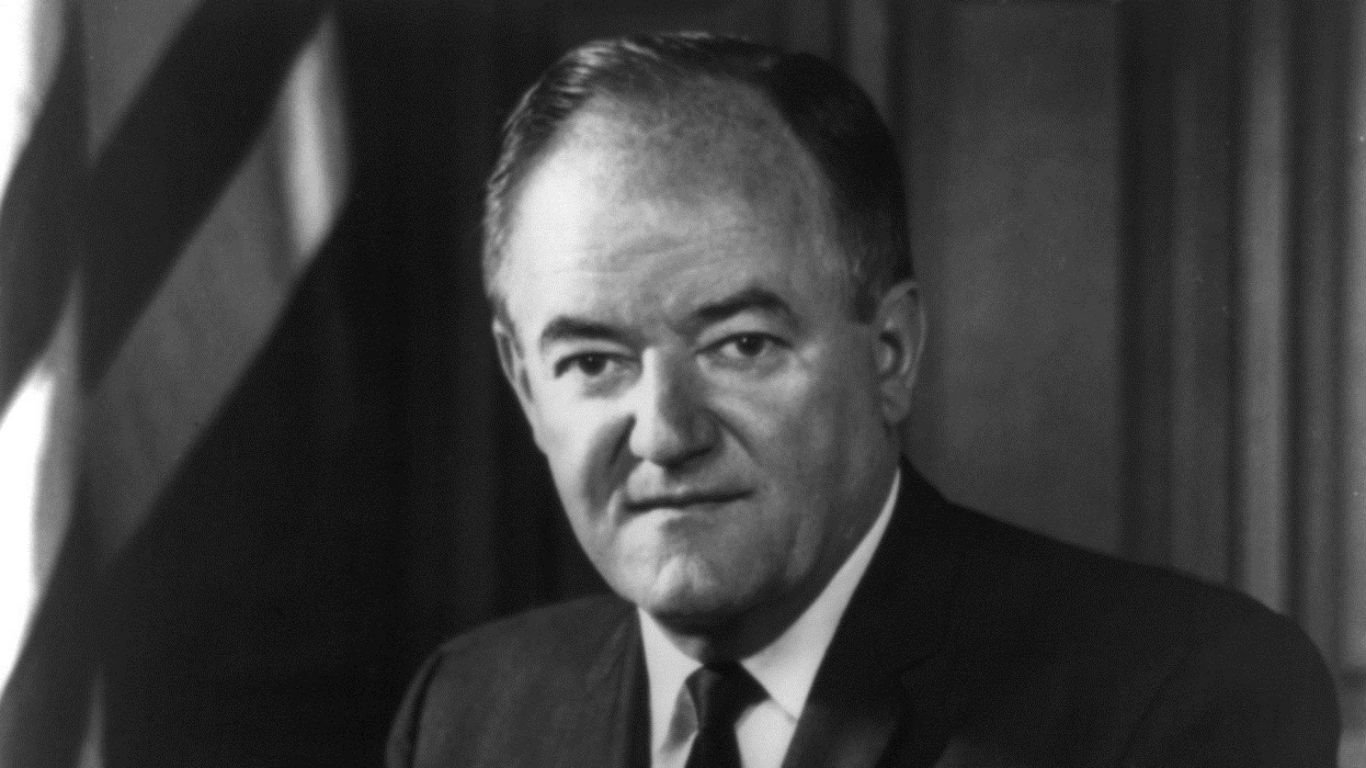
38. Hubert H. Humphrey
> Presidential administration(s): Lyndon B. Johnson
> Year(s) in office: 1965 – 1969
> Party affiliation: Democratic
The energetic Hubert H. Humphrey, known as the “Happy Warrior,” represented Minnesota in the Senate from 1949 to 1964 and was known as a champion of labor and civil rights before his time as vice president. His speech at the 1948 Democratic National Convention calling for full equality regardless of race, class, or religion made him a national figure. Humphrey was one of the champions of the Nuclear Test Ban Treaty and the 1964 Civil Rights Act.
Those credentials, plus the geographical balance of a northern liberal on the Democratic ticket, were the reasons Lyndon B. Johnson chose him as vice president. Humphrey was a staunch advocate for LBJ’s Great Society program and helped get the 1965 Voting Rights bill passed. Humphrey hoped the VP post would lead to the presidency. However, the Johnson administration association with the unpopular Vietnam War hurt Humphrey’s bid for president in 1968 and he lost to Republican Richard Nixon.
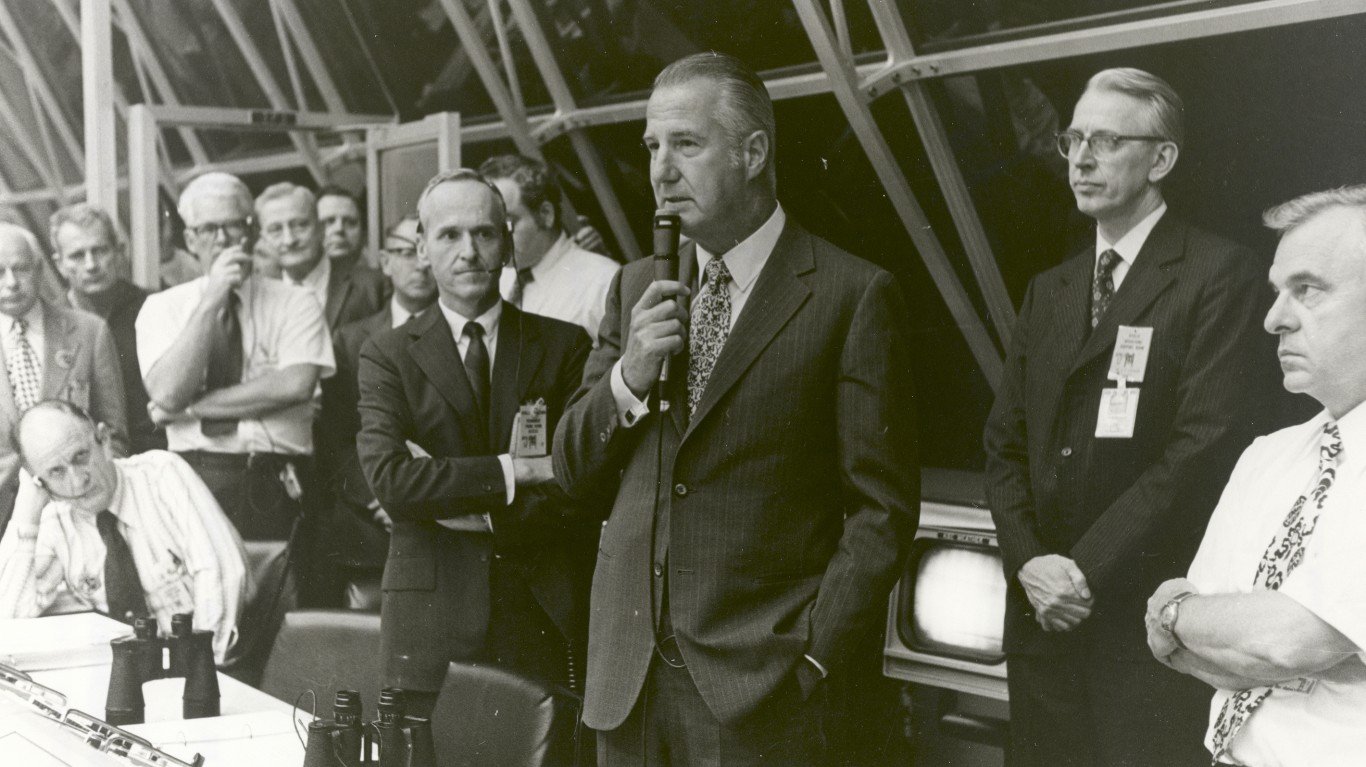
39. Spiro T. Agnew
> Presidential administration(s): Richard Nixon
> Year(s) in office: 1969 – 1973
> Party affiliation: Republican
Spiro T. Agnew, the son of Greek immigrants, became one of the most controversial vice presidents by taking on the media, calling them an “unelected elite” biased against his boss, President Richard Nixon. Agnew had ascended the political ladder in his native Maryland as a progressive Republican, but took a harder line on racial issues after he was elected governor. Nixon picked the relatively unknown Agnew to run as vice president because he thought the choice of Agnew would help him win the southern vote.
Once in office, Agnew quickly discovered the restraints of the job as president of the Senate and some procedural gaffes hurt his standing among senators. He was also shut off from the president by Nixon’s famously protective aides. Agnew resigned because of a tax and bribery scandal in 1973, the second vice president ever to resign after John C. Calhoun.
[in-text-ad-2]
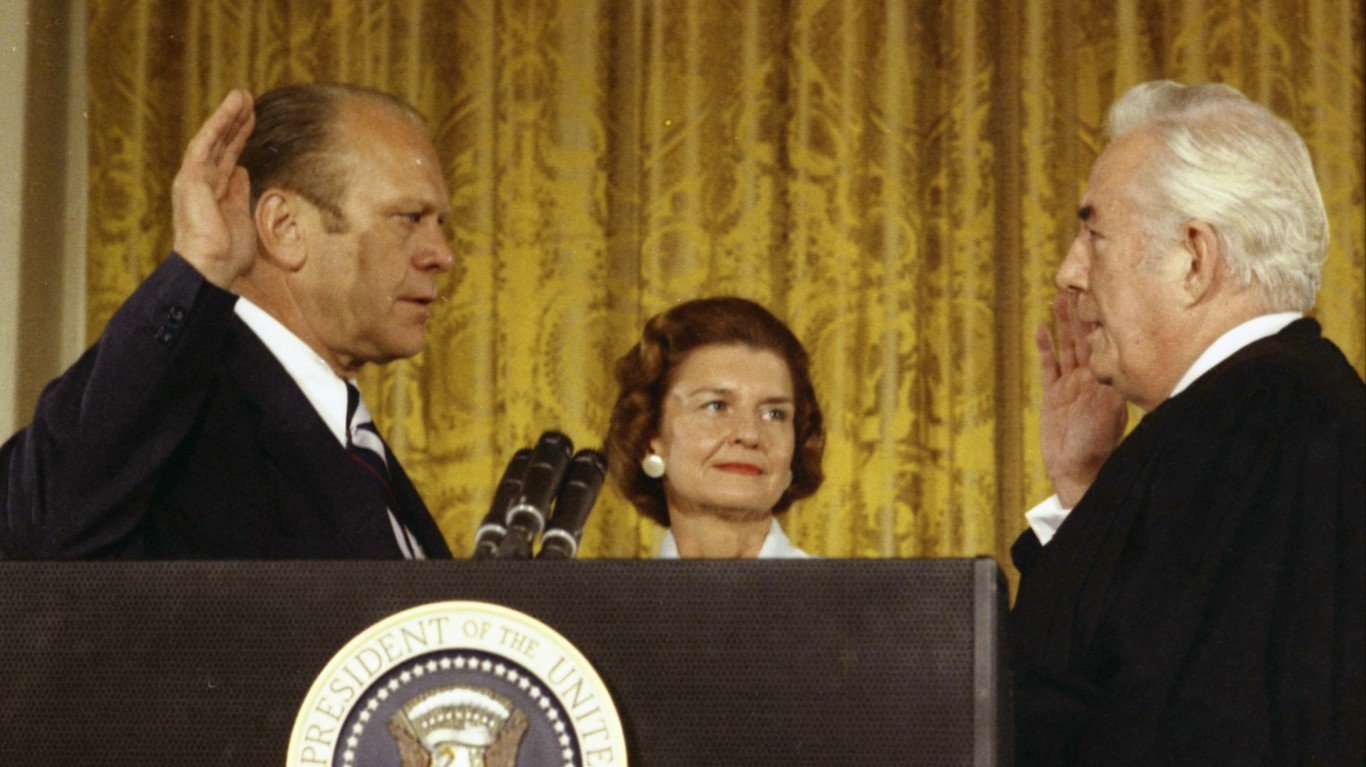
40. Gerald R. Ford
> Presidential administration(s): Richard Nixon
> Year(s) in office: 1973 – 1974
> Party affiliation: Republican
Gerald R. Ford assumed the vice presidency in 1973 under unusual circumstances. Ford became the first VP appointed under the terms of the 25th Amendment after Spiro T. Agnew resigned in the wake of a bribery and tax scandal. Due in large part to his reputation for bipartisanship and integrity built on 25 years of serving in Congress, Ford’s nomination was approved overwhelmingly by Congress.
Ford tried to maintain a balance between being a loyal vice president under Nixon and distancing himself from the taint of the Watergate scandal. The Michigan native would not be vice president that long. Barely eight months later, Nixon resigned and Ford became president.
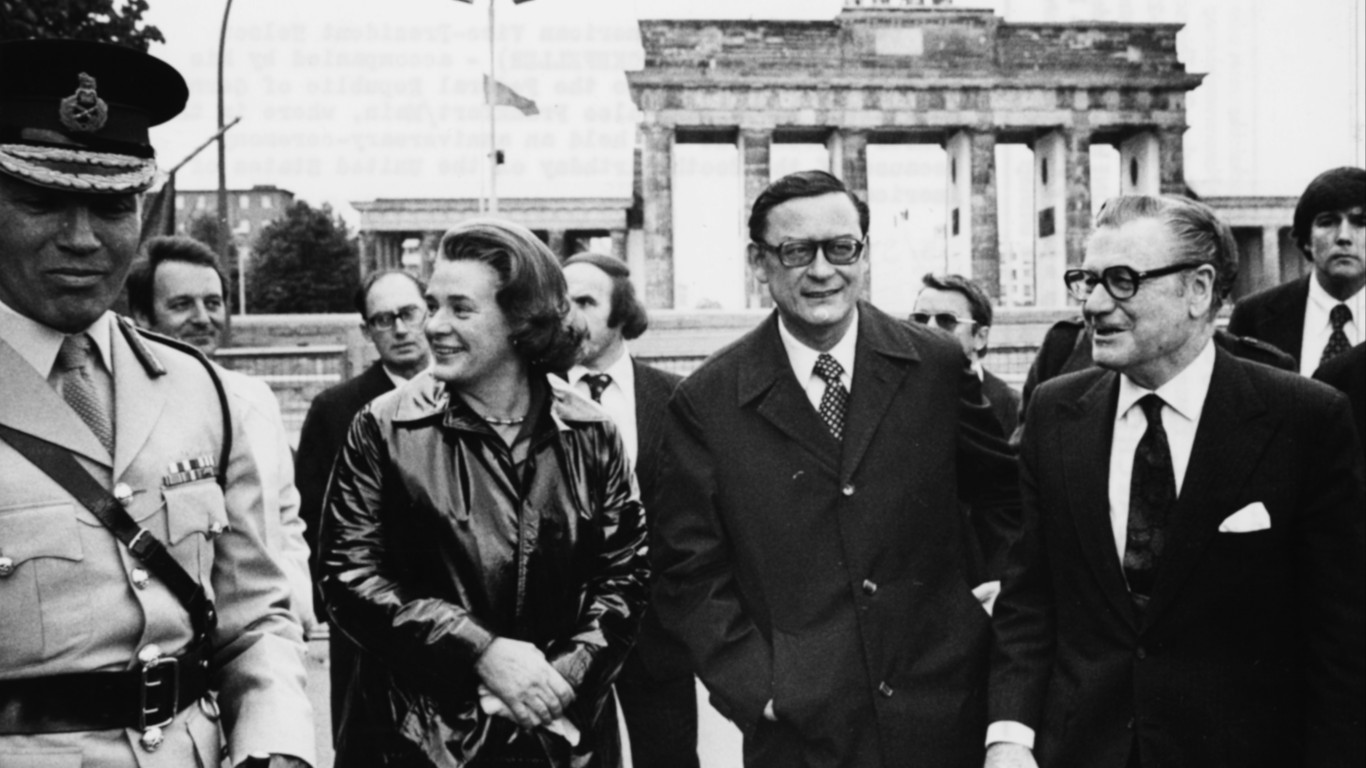
41. Nelson A. Rockefeller
> Presidential administration(s): Gerald Ford
> Year(s) in office: 1974 – 1977
> Party affiliation: Republican
Nelson A. Rockefeller, born into one of the wealthiest families in the United States, was an influential Republican from New York whose more moderate positions on several issues put him at odds with the more conservative wing of the GOP, hindering his own chance of becoming president. Rockefeller had served in the Roosevelt and Eisenhower administrations and was elected governor of New York four times.
After Richard Nixon resigned in 1974 and Gerald Ford succeeded him, Ford chose Rockefeller as vice president because of his executive expertise and the belief that Rockefeller would broaden the ticket’s electoral appeal in 1976. Ford and Rockefeller met once a week, but for the most part, Rockefeller was shut off from involvement in important policy matters. With the party moving to the right, Rockefeller was forced to withdraw from the ticket in 1976.
[in-text-ad]
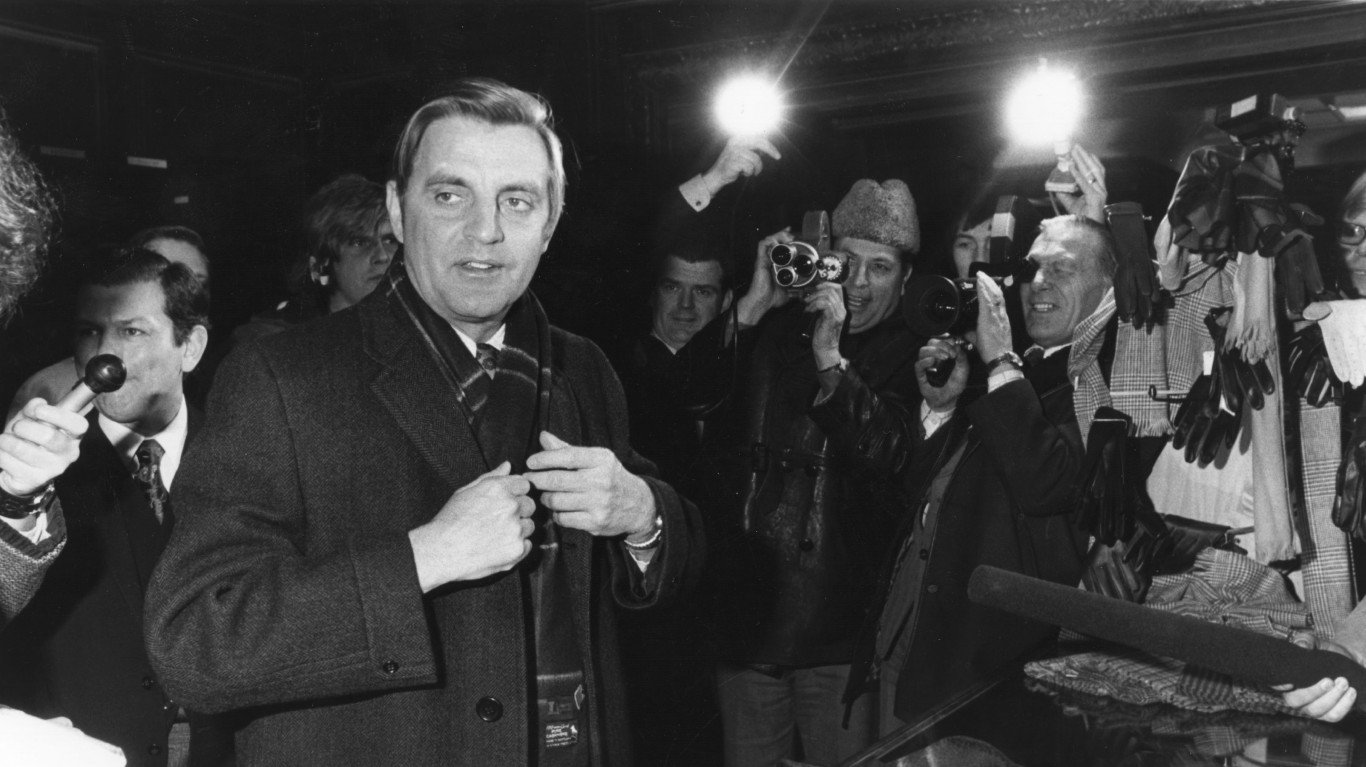
42. Walter F. Mondale
> Presidential administration(s): Jimmy Carter
> Year(s) in office: 1977 – 1981
> Party affiliation: Democratic
With the death of George H.W. Bush in 2018, Walter F. Mondale became the oldest living former U.S. vice president. Mondale, whose politics evolved from New Deal policies, began his career in the Senate in 1964 after he was appointed to fill the Minnesota seat vacated by Hubert Humphrey who had been elected vice president.
Mondale thought about running for president in 1976, like other senators that year, but decided not to. When former Georgia Gov. Jimmy Carter won the nomination, he chose Mondale to run with him because Mondale convinced Carter that he wanted the VP office to be meaningful and not ceremonial. After they were elected, Carter and Mondale formed a close team, with the president declaring that Mondale be given an office inside the West Wing. Carter also wanted the presidential and vice-presidential staffs combined into one working unit.

43. George H.W. Bush
> Presidential administration(s): Ronald Reagan
> Year(s) in office: 1981 – 1989
> Party affiliation: Republican
Few public servants can boast a resume as impressive as that of George H.W. Bush: Naval air pilot, congressman, U.N. ambassador, chief U.S. liaison officer to the People’s Republic of China, and director of the CIA. Bush ran against Ronald Reagan for president in 1980 and lost the nomination. Reagan initially wanted Gerald Ford as vice president, but Ford envisioned the office as a co-presidency, and Reagan rejected the idea. When Reagan offered the job to Bush to broaden the ticket ideologically, he gladly accepted.
Bush proved to be a loyal No. 2, never disclosing publicly what he and the president discussed. Reagan put Bush in charge of task forces on deregulation and combating drug smuggling.

44. J. Danforth Quayle
> Presidential administration(s): George H. W. Bush
> Year(s) in office: 1989 – 1993
> Party affiliation: Republican
J. Danforth Quayle, better known as Dan Quayle, served as vice president under George H. W. Bush from 1989 to 1993 and was an advocate for family values. Even though he represented Indiana in the House and Senate from 1977 to 1989, his selection as vice president by Bush was met with derision because Quayle was seen as a lightweight. This was underscored during vice presidential candidates debate with Lloyd Bentsen. When Quayle invoked John F. Kennedy, Bentsen replied that he knew Kennedy well, saying, “Senator, you are no Jack Kennedy,” to uproars from the crowd.
Bush and Quayle won the 1988 election. As vice president, Quayle traveled extensively on goodwill missions. He also helmed the President’s Council on Competitiveness, which reviewed new federal regulations and proposed judicial reforms. Still, throughout his vice presidency, Quayle was widely ridiculed by the media and the public.
[in-text-ad-2]

45. Albert A. Gore
> Presidential administration(s): William J. Clinton
> Year(s) in office: 1993 – 2001
> Party affiliation: Democratic
Albert A. Gore, the son of a Tennessee senator, was raised in Washington D.C. and was expected to go into politics. He was elected to Congress at age 28 in 1976 and won a Senate seat in 1984, immersing himself in issues such as nuclear arms control, toxic waste cleanup, biomedical research, and genetic engineering.
Gore was rebuffed in his bid for the presidency in 1988 and chose not to run in 1992. Gore opposed the Bush administration’s stand on global warming, and agreed to become Bill Clinton’s vice presidential candidate. Gore brought to the ticket his credentials as a Vietnam War veteran and long experience as a lawmaker in Congress. Once they were elected, Clinton and Gore met regularly, and Clinton named Gore as an adviser on nominations. Gore remains an environmental activist and received a Nobel Peace Prize for his work in the field in 2007.
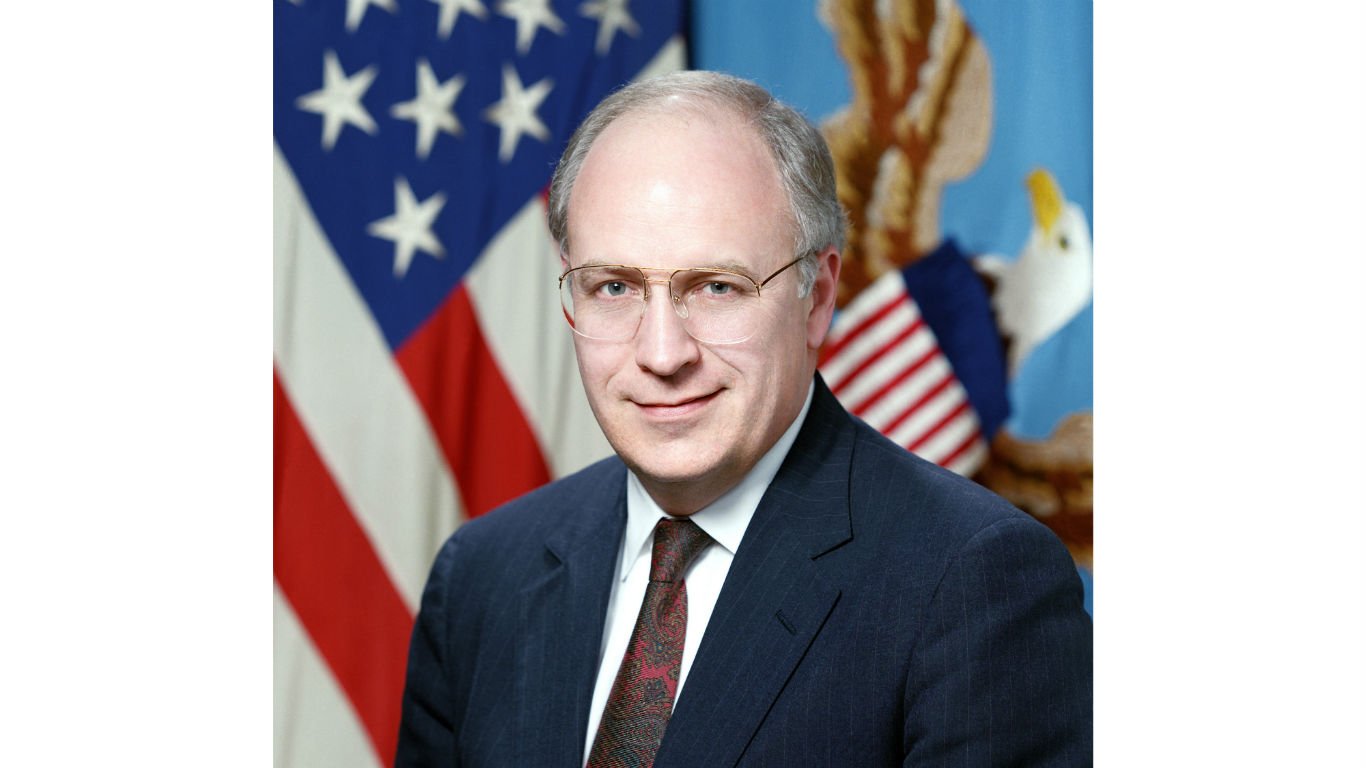
46. Richard B. Cheney
> Presidential administration(s): George W. Bush
> Year(s) in office: 2001 – 2009
> Party affiliation: Republican
Richard B. Cheney began his rise up the political ladder as a pragmatic, low-key problem solver under the tutelage of Donald Rumsfeld in the 1970s. When Rumsfeld became secretary of defense under President Ford in 1975, Cheney succeeded Rumsfeld as Ford’s chief of staff. Ford would be one of four presidents Cheney would serve. After Ford lost to Jimmy Carter, Cheney returned to Wyoming where he had grown up and won the first of his six terms in the House of Representatives.
President George H.W. Bush named him secretary of defense in 1989. That experience led Bush’s son, George W. Bush to choose him as vice president in 2000. As VP, Cheney formed a task force to undo restrictions on oil and gas exploration. Cheney was hawkish on defense and supported the invasion of Afghanistan and later Iraq.
[in-text-ad]
47. Joseph R. Biden, Jr.
> Presidential administration(s): Barack Obama
> Year(s) in office: 2009 – 2017
> Party affiliation: Democratic
Joseph R. Biden, Jr., the 2020 presumptive Democratic Party candidate for president, served in Congress from 1973 to 2009, chaired the Senate Committee on Foreign Affairs, and ran for president in 1988 and 2008.
Biden’s congressional experience and working class roots were factors behind Obama selecting him as a vice presidential candidate. As VP, Biden helped craft policies for Iraq and Afghanistan and worked to implement the New Strategic Arms Reduction Treaty between the United States and the Russian Federation. Biden was also a vigorous supporter of the Affordable Care Act. In the closing days of the Obama presidency, Obama presented Biden with the Presidential Medal of Freedom, the nation’s highest civilian honor.
48. Michael R. Pence
> Presidential administration(s): Donald Trump
> Year(s) in office: 2017 – present
> Party affiliation: Republican
Michael R. Pence, the current vice president under President Donald Trump, was a former radio talk show host before he won six terms to the House of Representatives as a congressman from Indiana. Pence was elected governor of Indiana in 2012. Trump picked Pence as his running mate because of his conservative record as congressman and governor.
Pence became the first vice president to cast a tie-breaking vote for a cabinet nomination when he voted for Betsy DeVos to be secretary of education. He is also an advocate for establishing an American Space Force. In February 2020, Trump put Pence in charge of overseeing the administration’s response to the COVID-19 pandemic.
Essential Tips for Investing: Sponsored
A financial advisor can help you understand the advantages and disadvantages of investment properties. Finding a qualified financial advisor doesn’t have to be hard. SmartAsset’s free tool matches you with up to three financial advisors who serve your area, and you can interview your advisor matches at no cost to decide which one is right for you. If you’re ready to find an advisor who can help you achieve your financial goals, get started now.
Investing in real estate can diversify your portfolio. But expanding your horizons may add additional costs. If you’re an investor looking to minimize expenses, consider checking out online brokerages. They often offer low investment fees, helping you maximize your profit.
Thank you for reading! Have some feedback for us?
Contact the 24/7 Wall St. editorial team.
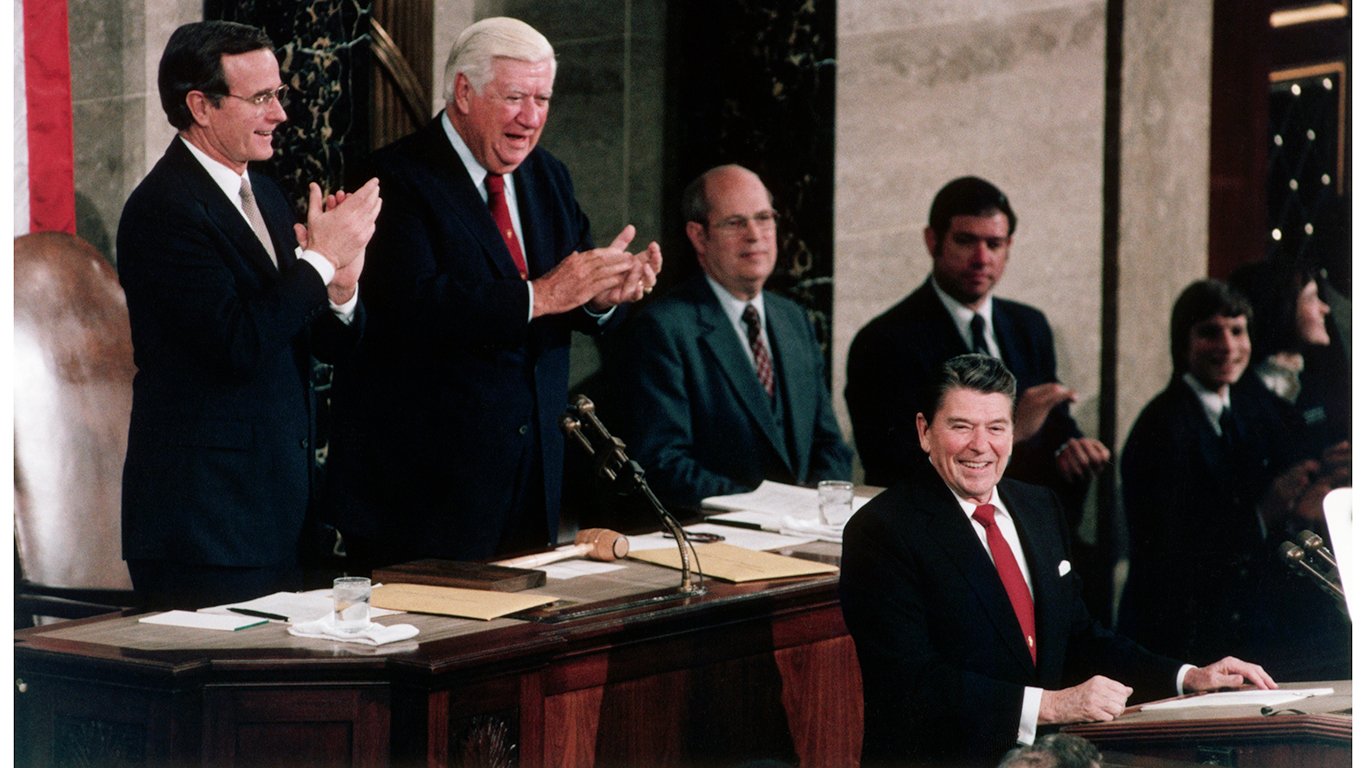 24/7 Wall St.
24/7 Wall St.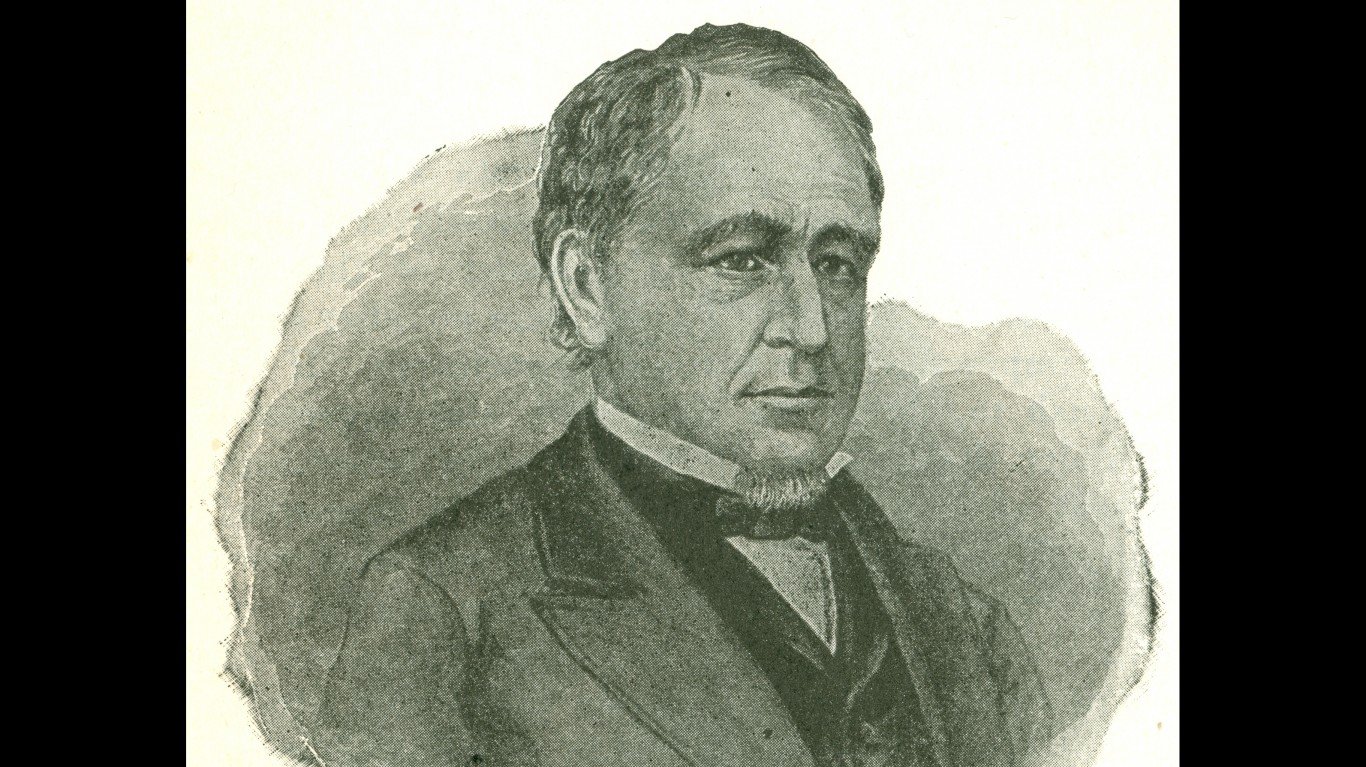
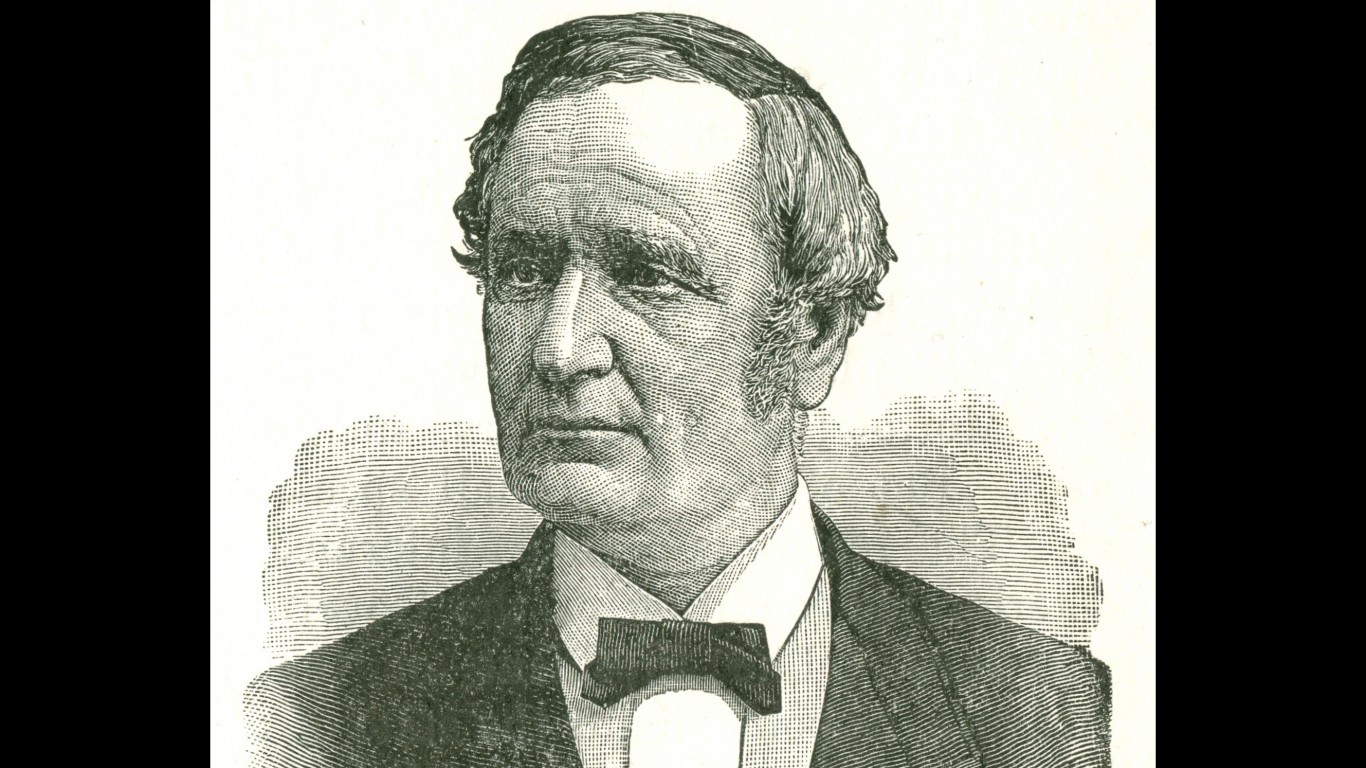
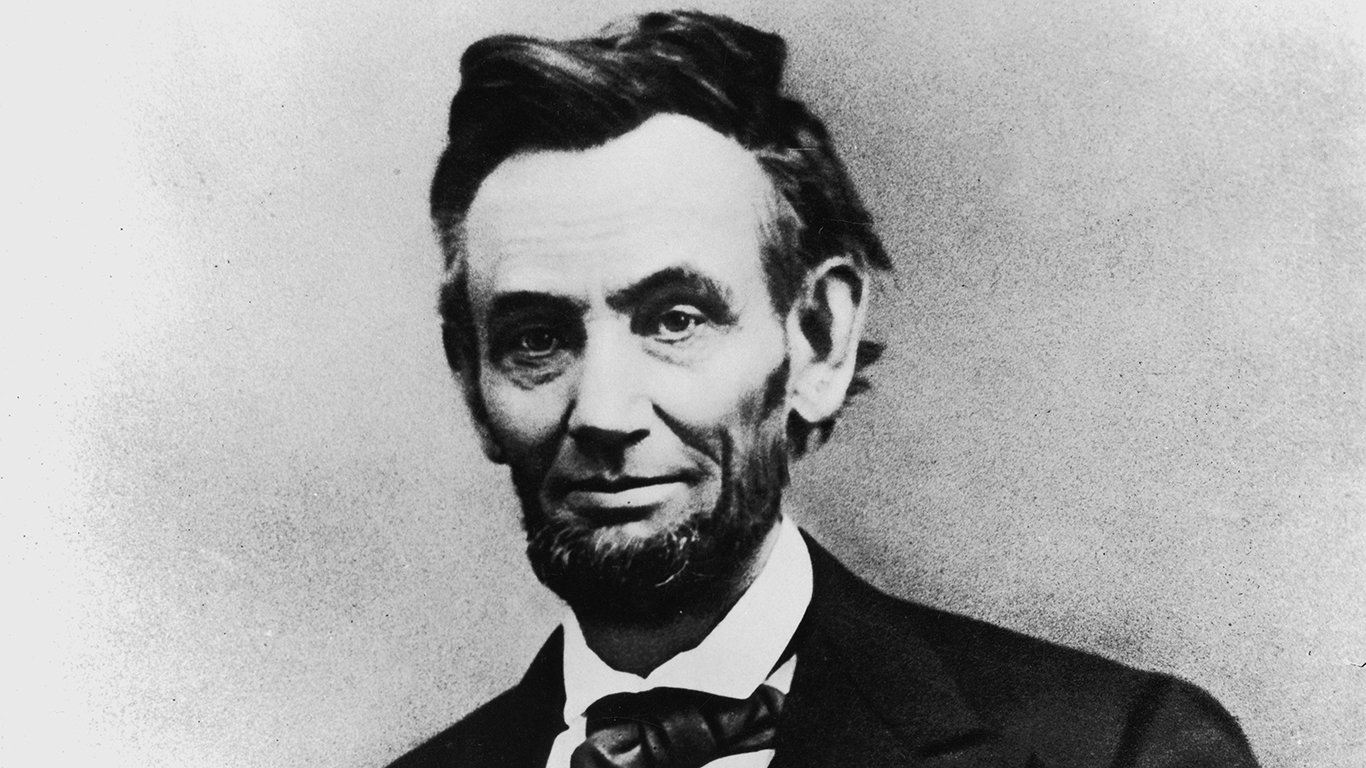 24/7 Wall St.
24/7 Wall St.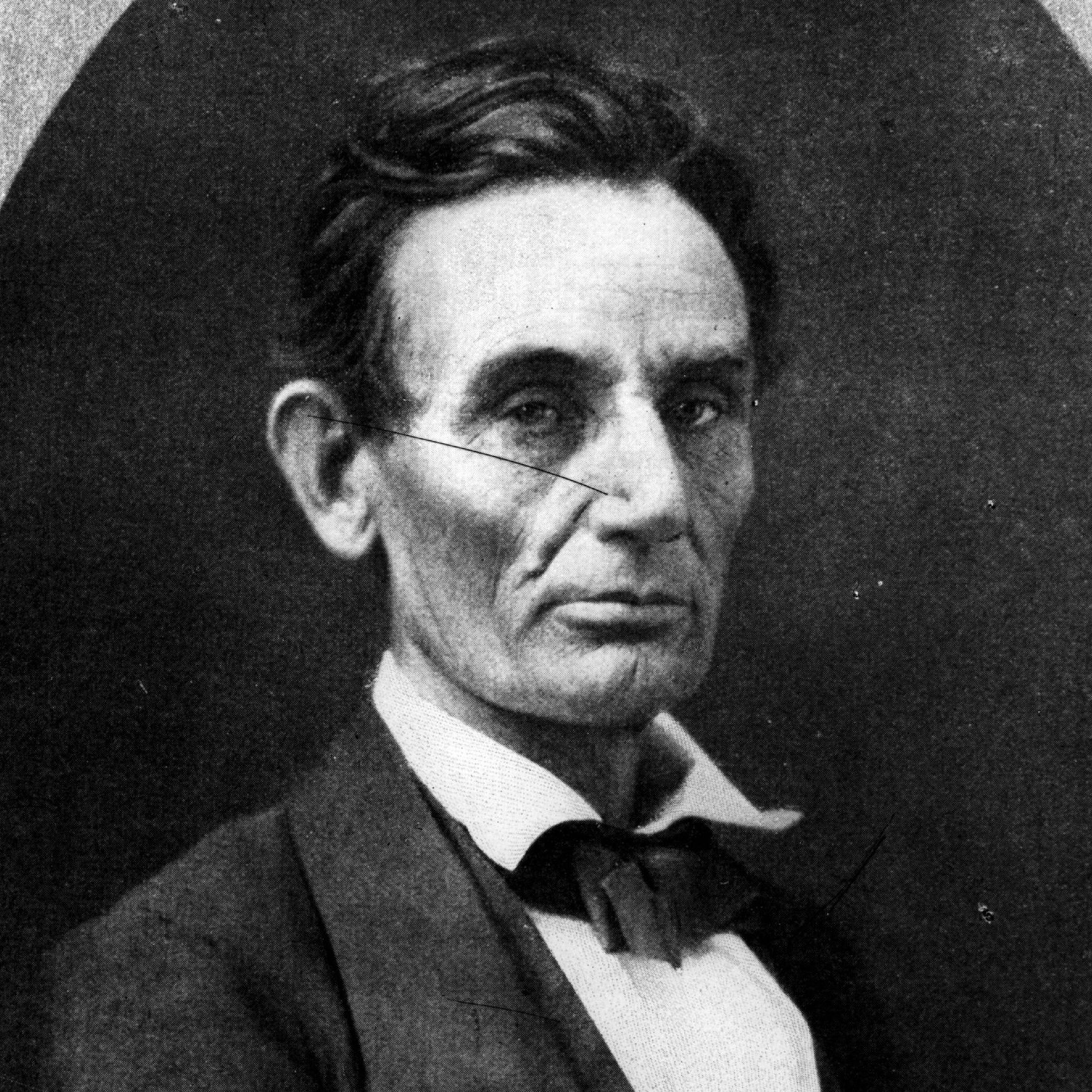 24/7 Wall St.
24/7 Wall St.